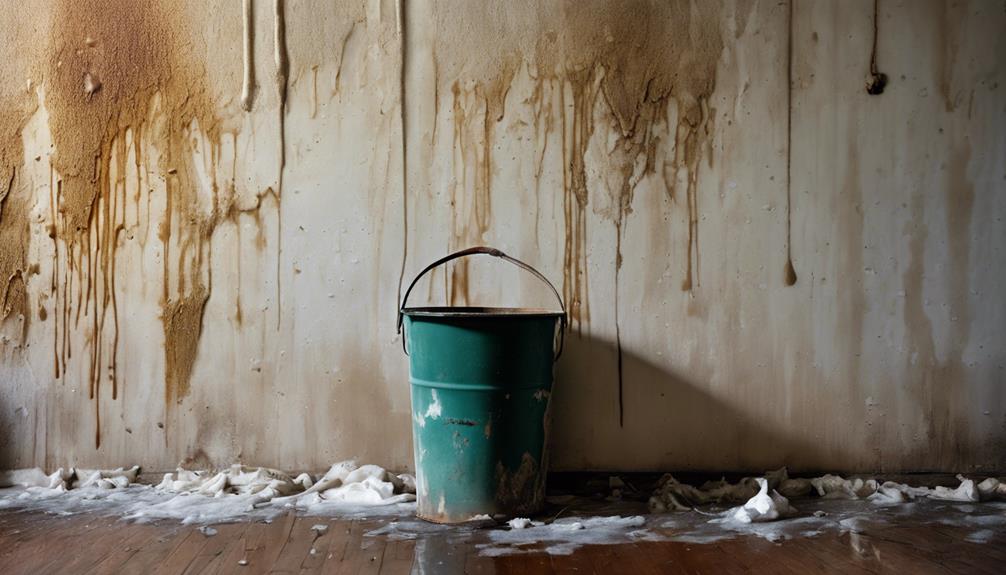
You have to disclose any history of water damage when selling your house. If you fail to do so, you could face serious legal consequences, including financial penalties and potential lawsuits from buyers. Water damage can lead to significant repairs and reduce your property's value. Being transparent about such issues builds trust with potential buyers. It's crucial to document any repairs related to water damage and understand your disclosure obligations under the law. Curious to know more about your rights and responsibilities when it comes to water damage? There's plenty of important information to consider before you sell.

Water damage is a serious concern that can significantly impact your property's value and safety. It can lead to severe structural issues, mold growth, and health risks, making it crucial to understand its implications when selling your home.
In California, you need to be aware of latent defects and the importance of disclosing any existing water damage during a home inspection. Homeowners should also consider reviewing their insurance coverage for water damage to understand potential financial protections and responsibilities.
Common sources of water damage include poorly maintained roofs, old plumbing, and leaks from appliances. Repair costs can range from about $2,800 to over $10,000 for severe cases, so identifying the source is essential for effective remediation.
If you notice any signs of moisture, it's vital to act quickly, as water damage can attract pests like termites that further compromise your property's integrity.
You should also consider that homeowners insurance may cover certain repairs related to water damage, but exclusions often apply for existing conditions. Being proactive about addressing water damage and understanding its implications can save you from potential legal and financial troubles down the line.
Always prioritize thorough inspections and necessary repairs to maintain your property's value and safety.
Understanding your seller disclosure obligations is crucial when selling a home in California. You're legally required to disclose known material defects, including any history of water damage, as stated in the Transfer Disclosure Statement (TDS). This obligation ensures transparency and protects both you and potential buyers.
Here's a quick overview of your seller disclosure responsibilities:
| Disclosure Requirement | Details |
|---|---|
| Water Damage History | Disclose any past incidents of water damage. |
| Significant Repairs | Document major repairs related to water issues. |
| Mold Issues | Report any mold problems that arose from water damage. |
| Legal Repercussions | Non-disclosure can lead to legal action from buyers. |
| Transparency | Honesty in disclosure promotes trust in the home sale. |
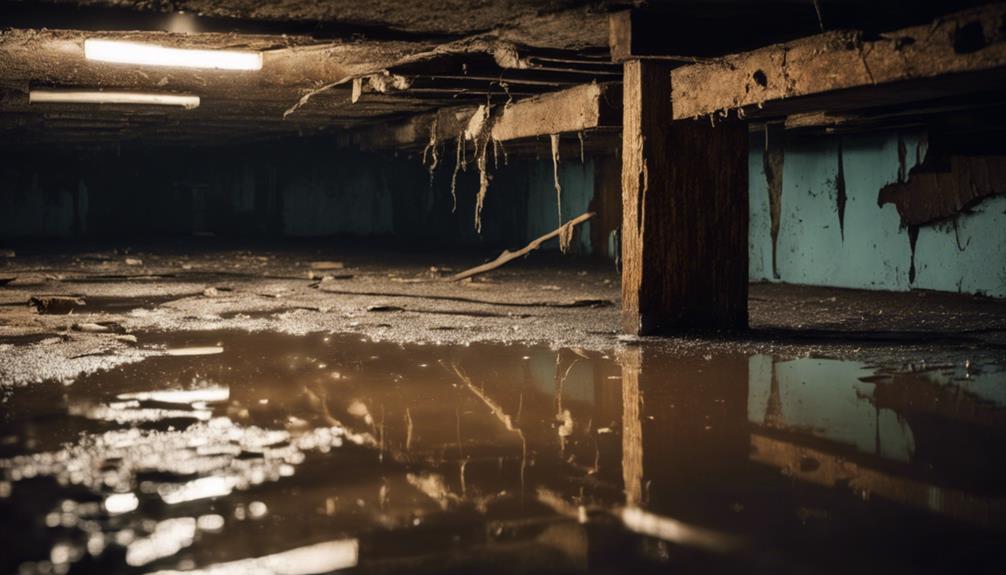
If you fail to disclose known water damage when selling your house, you could face serious legal consequences.
Buyers have rights and remedies available to them, which may include seeking compensation for repairs and damages.
Understanding these implications can protect you from potential lawsuits and help you navigate the selling process more effectively.
Selling a house comes with a responsibility to disclose known issues, and ignoring this duty can lead to serious legal consequences. In California, as a seller, you must disclose any material facts, including a history of water damage. Failure to do so can result in legal action for non-disclosure or misrepresentation, which can be costly.
Concealing water damage not only risks your reputation but can also lead to significant financial penalties. Buyers may seek compensation for repair costs or reductions in property value due to your lack of disclosure. If they discover undisclosed water damage post-sale, they've the right to take legal action against you, making it essential to be transparent.
Intentionally hiding water damage can escalate the situation to allegations of fraud, complicating legal proceedings and potentially leading to harsher penalties against you. Additionally, buyers may claim emotional distress if they feel deceived.
In real estate transactions, honesty is crucial; the legal consequences of concealment can far outweigh any temporary benefits you might perceive from hiding such critical information. Protect yourself by being upfront about any water damage.
Buyers have specific rights when it comes to undisclosed water damage, and knowing these rights can help protect your investment. In California, the seller is required to disclose material facts, including any known water damage, as it can significantly affect property value.
If a home seller fails to disclose such information, you may pursue several remedies.
Navigating these issues can be complex, so it's crucial to consult with qualified real estate attorneys for legal advice tailored to your situation.
They can guide you through the legal implications of non-disclosure, ensuring you understand your buyer rights and remedies.
Many homeowners may not realize the subtle signs of water damage lurking in their property. Common indicators include discoloration on walls or ceilings, which often suggests leaks or moisture buildup.
If you notice a musty odor, that could signal visible mold growth, a direct result of undetected water damage. This poses serious health risks and requires immediate attention.
Additionally, warped or buckled flooring, particularly near bathrooms or kitchens, can indicate previous water exposure and potential structural issues.
Keep an eye out for stains on carpets or walls that persist even after cleaning; these may point to hidden water damage that needs further investigation.
If you've made repairs, it's crucial to disclose any history of water damage on your disclosure form. Being upfront about visible mold growth or past leaks not only protects you legally but also fosters trust with potential buyers.
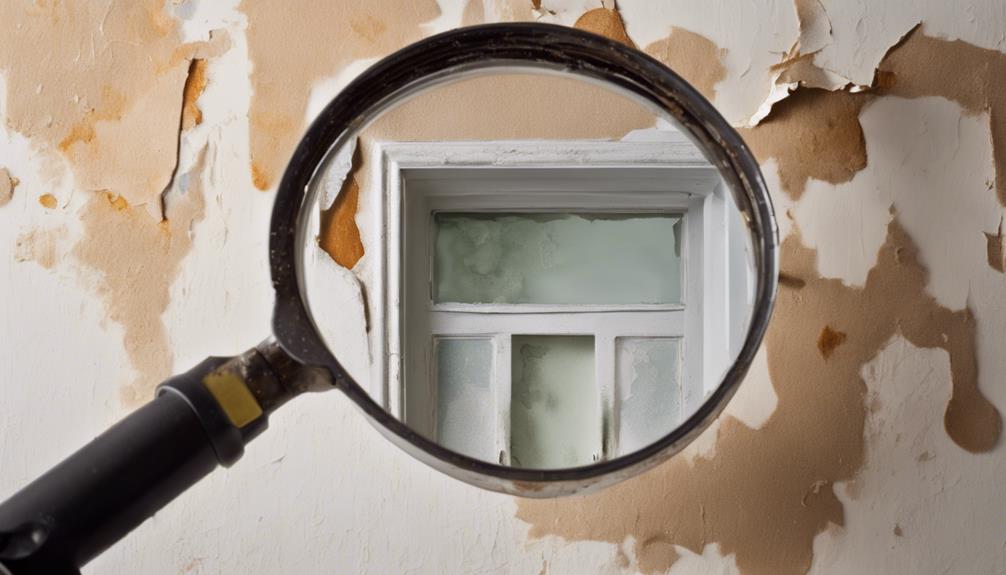
Investing in a comprehensive home inspection is essential for uncovering hidden issues, particularly those related to water damage. In California, while sellers are required to disclose known issues, many latent defects may remain hidden without a professional inspection.
By engaging an inspector before making an offer, you can avoid unexpected repair costs that average around $2,800 for water damage repairs.
Here are some key benefits of home inspections:
During inspections, be on the lookout for discoloration, musty odors, and other indicators of water damage.
A thorough inspection empowers you to make a sound investment and ensures that you're aware of the true state of the property.
Ultimately, a professional inspection can save you significant money and stress, making it an invaluable step in the home-buying process.
Understanding the seller's knowledge of any past water damage is vital when you're considering a property. Sellers are legally obligated to disclose known water damage if they're aware of it. If the seller knew about the damage and fails to disclose it, they could face significant legal consequences under California real estate law.
To establish this knowledge, look for evidence such as repair records, contractor testimony, or insights from neighbors. The seller's intent also plays a crucial role; proving they knowingly concealed water damage can bolster your claim for nondisclosure. Such documentation can indicate that the seller was aware of the issue, potentially substantiating your claims in any legal proceedings.
Additionally, professional inspections are essential. They help uncover any undisclosed water damage, which can further support claims against sellers for failing to disclose material defects.
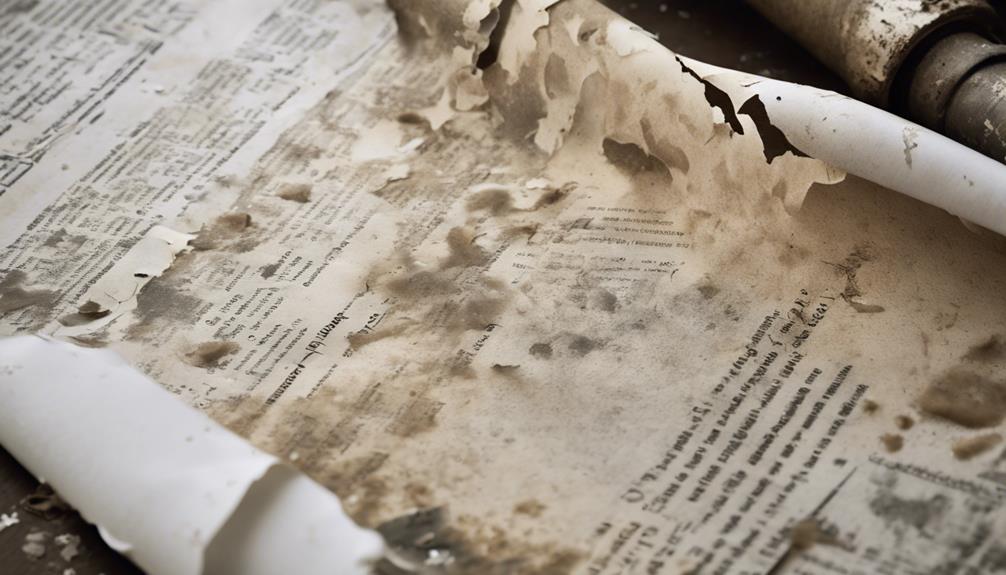
If you discover water damage after purchasing a home, taking immediate legal steps is crucial to protect your rights.
Start by consulting a California real estate attorney who can guide you through your options. If you can prove that the seller failed to disclose the issue, you may have grounds for legal action. Evidence such as contractor testimony or repair documentation will be valuable in building your case.
Here are some steps to consider:
Once you've assessed your legal options after discovering water damage, it's important to explore potential remedies that can help mitigate your losses.
In California, you can seek compensation for repair costs related to undisclosed water damage, which typically averages around $2,800 but can exceed $10,000 based on damage severity.
Legal remedies available to you include claims for reduced property value due to undisclosed defects, and you might even seek recovery for emotional distress caused by the seller's nondisclosure.
Acting quickly is crucial, as California's statutes of limitations can limit your time frame for filing claims regarding non-disclosure.
Start with negotiation and mediation with the home sellers; these initial remedies often lead to compensation for necessary repairs without the hassle of litigation.
However, having an experienced real estate attorney can make a significant difference. They can provide you with essential guidance on your rights and the potential success of your claims concerning undisclosed water damage.
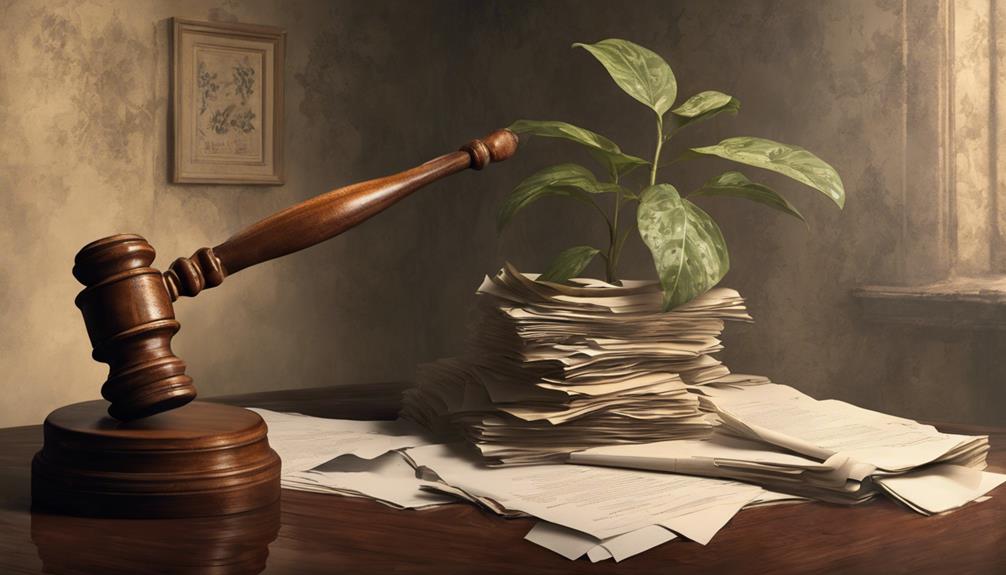
Navigating the complexities of disclosure laws can be daunting, especially when it comes to water damage. That's where legal representation becomes vital. An experienced attorney helps you comply with California Civil Code requirements, ensuring you disclose water damage properly. This guidance is crucial for preparing the Transfer Disclosure Statement (TDS) accurately, which can protect you from liability for undisclosed defects.
Consider these key points:
With legal representation, you can navigate the nuances of water damage disclosures confidently. You'll not only safeguard yourself against potential water damage claims, but you'll also ensure that your sale goes smoothly.
Understanding your responsibilities and having someone to guide you through the process helps mitigate risks associated with undisclosed defects. Ultimately, having an experienced attorney by your side can make a significant difference in protecting sellers' interests throughout the sale.
Yes, water damage significantly affects your home's value.
It can lead to lower home appraisals and negative buyer perception, making potential buyers wary. Repair costs can easily exceed $2,800, impacting your ability to negotiate.
Additionally, insurance implications may arise, complicating the sale. Market trends show homes with water damage struggle during property inspections, often requiring a lengthy remediation process, which further diminishes their worth in the eyes of prospective buyers.
If you're selling a property, you've got seller responsibilities that include adhering to disclosure laws.
Failing to disclose defects can lead to legal implications, including potential lawsuits from buyers. They're protected by laws that require transparency, and property inspections often reveal hidden issues.
Ethically, you should disclose known problems to avoid complications. Offering home warranties can help mitigate concerns but doesn't replace the need for honesty about defects that could impact the buyer's decision.
When selling a house in California, you've got to adhere to strict disclosure requirements.
Your seller obligations include revealing the property's condition, any inspection reports, and potential environmental hazards.
Buyers have rights to know about significant defects, so be honest about issues like structural damage or past repairs.
Failing to disclose could lead to serious legal implications, including lawsuits.
Transparency not only protects you but also fosters trust in the transaction process.
You need to understand the importance of damp in your home.
It's crucial to know damp detection methods and damp inspection importance before selling.
Consider damp prevention tips to avoid issues, especially in basements.
If you've dealt with damp, explore damp repair solutions to ensure a healthy environment, as damp health risks can affect buyers.
Remember, having damp insurance coverage can help protect you if problems arise after the sale.
Transparency is key!
When selling your house, it's crucial to disclose any water damage. Not only does it protect you legally, but it also fosters trust with potential buyers. Ignoring this obligation can lead to serious legal consequences and financial losses. By being transparent and conducting thorough inspections, you can avoid disputes down the line. Always consider getting legal representation to guide you through the process and ensure you're meeting all disclosure requirements. Your honesty can make a big difference!
To talk to an insurance adjuster about water damage, start by gathering your documentation. Take clear photos of the damage and log the details of your interactions. Know your policy—understand what's covered and any limitations. When you connect with the adjuster, calmly share your evidence and discuss the source of the water. Ask questions about the claims process and coverage specifics. It's also smart to keep a record of everything discussed. Staying organized and informed will help you negotiate effectively. If you keep going, you'll discover more tips for navigating this complex process.
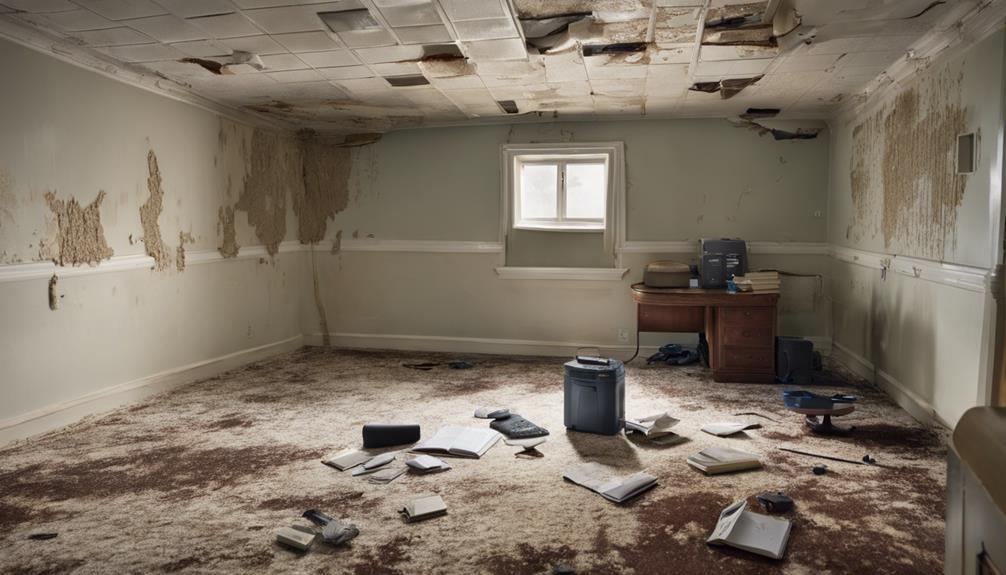
What should you do first after experiencing water damage? Start by identifying the source and, if it's safe, stop the flow, like shutting off the main water valve.
Next, document the damage thoroughly. Capture detailed photographs and videos of the affected areas and items; these will serve as crucial visual evidence for your insurance claim. It's also important to review your insurance policy for coverage details, as understanding your insurance coverage for water damage can help you navigate the claims process more effectively.
Once you've documented the damage, it's time to mitigate further damage. Dry wet areas and ensure proper air circulation to prevent mold growth, which can start within 24-48 hours.
After taking those initial steps, contact your insurance company promptly. Most providers offer 24/7 claim reporting, allowing you to kick off the insurance claim process without delay.
As you progress, keep thorough records of all actions taken. Save receipts for any temporary repairs or mitigation efforts, as these will support your claim submission when the claims adjuster reviews your case.
Understanding your insurance coverage is crucial after experiencing water damage. Start by reviewing your insurance policy to identify the specific coverage limits and exclusions related to water damage claims. Many policies only cover sudden and accidental incidents, while neglect or gradual damage may not be included. In fact, 25% of home insurance claims were due to water damage in 2018, so grasping your coverage is vital.
Typically, coverage for water damage from non-flood sources is included in standard policies, but it's essential to double-check your policy for details. Familiarize yourself with the difference between Actual Cash Value (ACV) and replacement cost coverage, as this affects the payout you'll receive for damaged items.
When obtaining repair estimates, ensure you have a clear understanding of what your policy covers. Additionally, if your home becomes uninhabitable due to water damage, your policy might cover additional living expenses, so look for any related provisions.
When negotiating settlement offers, being well-informed about your insurance coverage and limitations will empower you to advocate effectively for your needs.
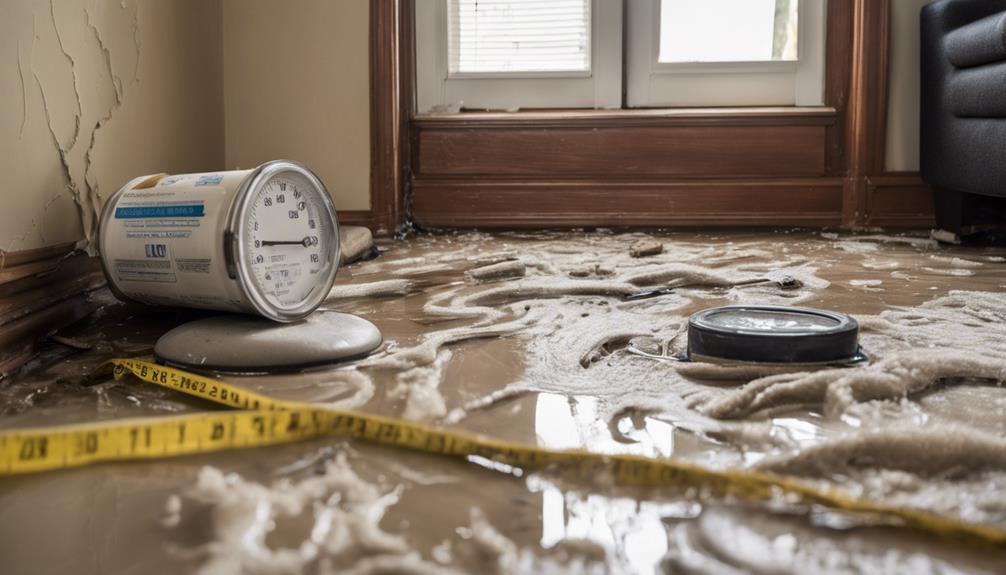
How can you ensure your water damage claim is processed smoothly? Start by thoroughly documenting water damage. Capture clear photographs and videos of all affected areas and items, making sure every detail is visible for the claims process. This visual evidence is crucial when you communicate with the insurance adjuster.
Next, maintain a detailed log of all interactions with the insurance company. Note the dates, times, and names of representatives you speak with; this can support your claim later. Don't forget to keep receipts related to any damage mitigation efforts, such as temporary repairs and professional cleaning services, as these documents will help you seek reimbursement.
As you assess the damage, document any visible and unseen issues over time, especially areas prone to mold or deterioration that might escape the adjuster's initial inspection.
Lastly, provide a comprehensive statement detailing the extent of the damage. Include descriptions of affected materials, their conditions, and a list of necessary repair work. This thorough approach will help prevent any additional damage to your claim and ensure a smoother process with your insurance company.
Once you've documented the water damage thoroughly, the next step involves effectively communicating with the insurance adjuster. Clear and direct communication can significantly impact your water damage claim outcome. Here are three key points to keep in mind:
Remember to maintain a professional and respectful demeanor during discussions. It fosters better communication and cooperation with the adjuster.
Additionally, keep a log of all interactions, noting dates, times, and content of conversations. This documentation can be invaluable in tracking your insurance claims and understanding the claims process, ultimately leading to a satisfactory settlement offer.
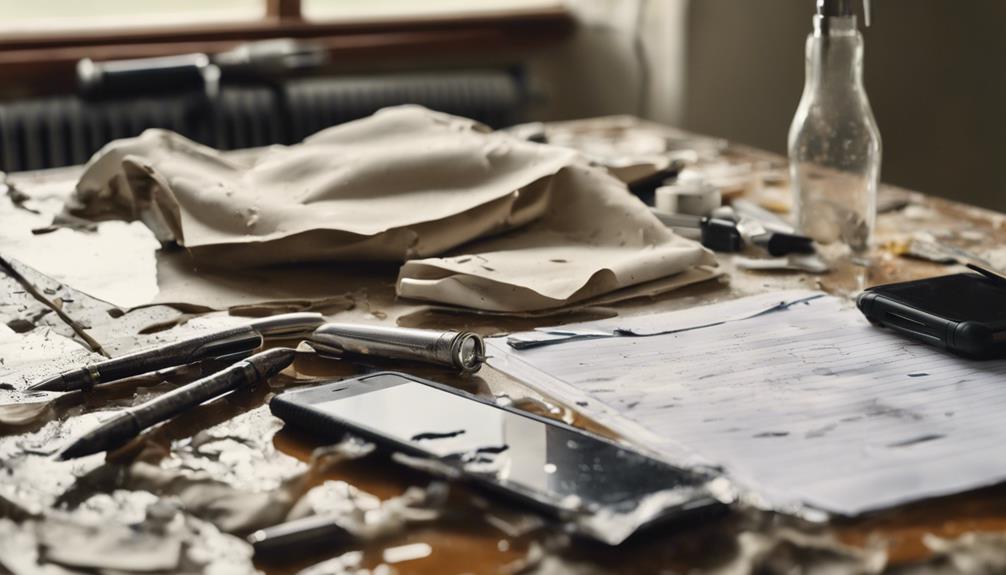
Asking the right questions during your conversations with the insurance adjuster can make a big difference in your claim process.
Start by inquiring about the timeline for receiving payment advances for both structural and content damage. This information can significantly impact your restoration efforts.
Next, ask for a precise estimation of the building loss amounts, so you understand the potential coverage you can expect for repairs.
It's also essential to seek clarification on specific coverage details and limitations in your homeowners policy. Knowing what's included in your water damage claim is crucial.
Confirm who'll assist you in detailing claims for all damaged items; this can help streamline the process and ensure all losses are accounted for.
Navigating the claims process can feel overwhelming, but knowing the steps to take can simplify it significantly. Here's a quick guide to help you through:
Throughout this process, maintain open communication with the adjuster. Provide any requested information promptly and keep detailed records of all interactions.
If the initial settlement offer seems low, don't hesitate to negotiate using your documentation. Remember, adjusters often rely on pricing guides that may not reflect local repair costs accurately, so advocate for yourself to ensure you receive fair compensation.

When handling disputes and settlements, it's crucial to understand your coverage terms and know exactly what damages you need to document.
If you receive a settlement offer that seems low, gather evidence to negotiate effectively.
Keeping detailed records of all interactions with the adjuster will also strengthen your position.
Understanding coverage terms in your insurance policy is crucial for effectively handling disputes and settlements with an adjuster. Knowing these terms will empower you to advocate for yourself during negotiations. Here are three key aspects to consider:
If disagreements occur regarding the settlement amount, don't hesitate to consult a public adjuster. They can help negotiate a fair resolution based on your coverage terms.
Always be prepared to present solid evidence of the damage, like photographs and repair receipts, to strengthen your case. By being well-informed and proactive, you'll increase your chances of a successful outcome when dealing with your insurance adjuster.
Thoroughly documenting damage is essential for a successful insurance claim, especially when disputes arise. Start by taking detailed photographs and videos of the water damage, ensuring you capture the extent of the destruction, including hidden areas. This visual evidence will support your claim effectively.
Don't forget to keep a record of all communications with the insurance company, noting dates, times, and the names of representatives. This creates a clear timeline of your interactions, which can be vital during disputes.
Additionally, maintain receipts for all expenses related to mitigation efforts, like temporary repairs and professional cleaning. These costs may be eligible for reimbursement in your settlement. Document the damages with descriptive notes, highlighting specific issues such as mold growth or structural damage. This information is crucial for the adjuster's evaluation.
If a dispute arises regarding the settlement amount, be prepared to present your documented evidence, including estimates from contractors and detailed lists of damaged items. This thorough documentation will strengthen your position and help you negotiate a fair resolution to your claim.
Negotiating settlement offers can feel daunting, but it's crucial to approach the process with confidence and preparation. Understanding your position can make a significant difference in the outcome. Here are three key steps to help you navigate the negotiation process effectively:
If the initial settlement offer seems insufficient, calmly present your evidence to advocate for a higher payout.
When you're dealing with challenges in your insurance claims, seeking additional resources and support can make a significant difference.
If you're facing difficulties with your insurance company regarding water damage claims, consider reaching out to the California Department of Insurance. They regulate the insurance industry and can help protect your rights during claims disputes.
Utilizing a public adjuster can also be beneficial; these professionals have expert negotiation skills and understand homeowners insurance policies inside and out, potentially maximizing your claim payouts.
It's essential to keep thorough documentation of all interactions with your insurance company. This documentation can support your claims and help resolve disputes effectively.
If you encounter unfair treatment or misconduct from insurance agents, report it to the California Department of Insurance. They offer resources for understanding your insurance-related inquiries.
Additionally, take advantage of free consultations often available for homeowners navigating the claims process. This support can guide you toward obtaining any additional compensation you may deserve.
With the right resources, you can effectively tackle your water damage claims and navigate the complexities of the insurance landscape more confidently.
When talking to a home claims adjuster, avoid common mistakes like admitting fault or discussing emotional responses.
Don't let adjuster tactics throw you off; stick to the facts. Factual inaccuracies can hurt your claim, so be clear and precise.
Watch for documentation errors and don't overlook your policy limits.
Always have repair estimates ready, and don't rush through claim timelines—patience can lead to a better outcome for your situation.
Insurance for water damage typically covers sudden incidents, like burst pipes, under water damage coverage.
When filing a claim, be aware of the types of water damage; clean water is usually covered, while gray and black water may have exclusions.
Documenting proof of damage is crucial, as is understanding deductible considerations and restoration costs.
Know the claim filing process and timeline expectations to navigate your policy exclusions effectively and ensure a smoother experience.
Your water damage claim might be denied for several common reasons.
If you've got maintenance issues or fail to report the damage in a timely manner, that could lead to problems.
Policy exclusions can also come into play, especially if the damage falls under lack of coverage.
Improper documentation or prior claims might raise red flags, while negligence claims could further complicate your situation.
Always ensure you understand your policy to avoid these pitfalls.
To make a successful water leak claim, start by documenting the damage thoroughly.
Gather your repair estimates and keep all receipts handy.
Review your policy coverage to understand what's included.
Adjust your expectations based on timeline factors, as claims can take time.
Provide clear documentation tips, like photos and logs of communications.
In conclusion, talking to an insurance adjuster about water damage doesn't have to be overwhelming. By understanding your coverage, documenting everything, and asking the right questions, you'll be better prepared to navigate the claims process. Remember, clear communication is key to resolving any disputes and securing a fair settlement. Don't hesitate to seek additional resources if you need help. You've got this, and your home deserves the best care!
If a plumber causes water damage in your home, start by assessing the situation and documenting the damage with photographs. Reach out to the plumber immediately, explaining what happened and documenting all communications. Don't forget to notify your insurance company to start the claim process promptly. Move any salvageable belongings to a dry area and consider hiring a restoration professional to mitigate further damage. Review your homeowner's insurance policy and understand your rights regarding plumber liability. With these steps, you'll be better prepared to handle the situation effectively and protect your interests. There's more to explore on this topic!
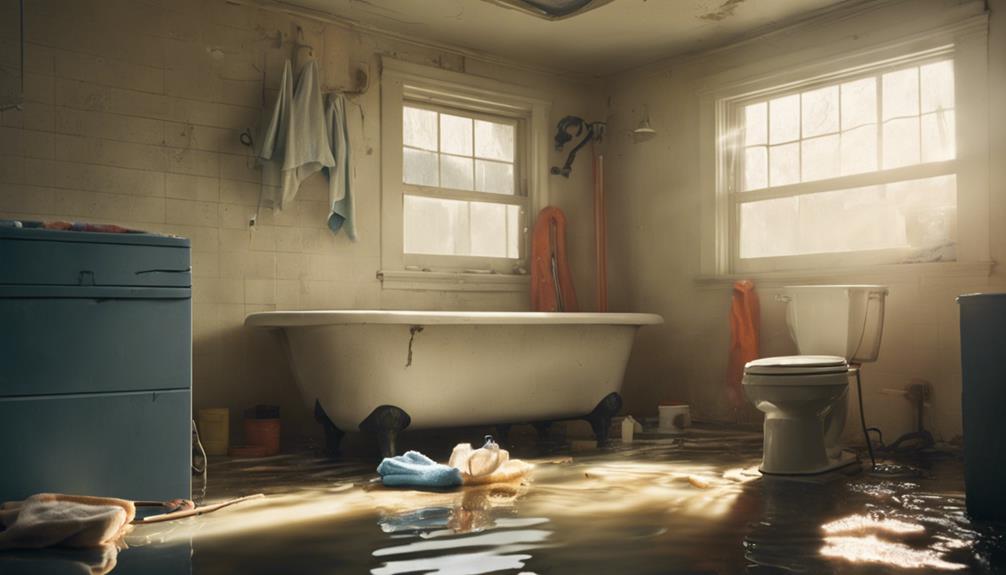
When faced with water damage from a plumber's mishap, the first step is to quickly assess the situation. Start by identifying the visible signs of water damage in your home, like water stains on ceilings, damp walls, or wet floors. These indicators help you assess the extent of the damage and prioritize your response.
It's important to document the damage through photographs and descriptions, as this can aid in the insurance claims process, especially if you have insurance coverage for water damage.
Next, locate the water source. If it's still leaking, turn off the main water supply to prevent further issues. While doing this, don't forget to check potential hazards, especially electrical risks. Water exposure can compromise outlets and wiring, so ensure safety first.
After addressing immediate concerns, evaluate the structural integrity of the affected areas. Look for any compromised beams or supports; these could pose serious safety risks.
If you spot any issues, it's crucial to act quickly, as structural damage can escalate.
Reach out to the plumber right away to let them know about the water damage caused during their service.
Be sure to document all your communications, including dates and details, so you have a clear record of the situation.
This will help ensure they take responsibility and have the chance to fix the issue.
Water damage can be a frustrating and stressful situation, especially when it results from plumbing work. Your immediate communication with the plumber is crucial. Start by contacting them as soon as you notice the issue. Explain the water damage in detail, highlighting the extent of the damage, including any visible signs like water stains or structural concerns. This clarity helps the plumber grasp the seriousness of the situation.
As you communicate, make sure to document all communications, noting the dates and times of your calls or messages. This record not only tracks your efforts but can also support any future insurance claims or legal actions.
Give the plumber a chance to respond and address the issue. They may have solutions or be willing to send a technician to assess the damage firsthand.
Keep a close eye on their response time and any actions they take. This information can be vital for your records, especially if you need to escalate the matter later on.
Documentation is essential in managing the aftermath of water damage caused by plumbing work. Start by immediately contacting the plumber responsible for the job. Inform them about the water damage, providing specific details about what you've observed. Clearly communicate the extent of the damage, including visible water stains, any structural issues, or affected materials.
Allow the plumber a chance to respond to the issue; they might offer to fix the problem or guide you on the next steps. During this interaction, it's crucial to document everything. Keep a record of all communications with the plumber, noting dates, times, and the content of your discussions. This documentation will be invaluable, especially if you need to file insurance claims or take legal action later.
Additionally, track the plumber's response time and any actions they take to address the problem. This information can bolster your case if disputes arise.
Effective documenting not only helps you manage the current situation but also ensures you have a solid foundation for any future claims or communications regarding the water damage.
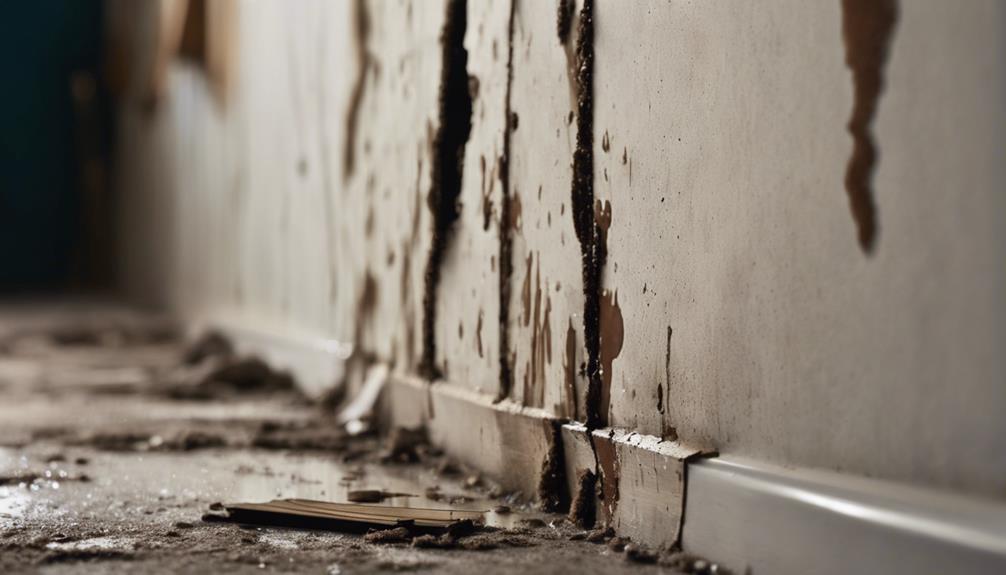
When water damage occurs, documenting the situation is crucial for a successful insurance claim.
You'll want to capture clear photos and videos of the affected areas and keep a detailed log of your observations.
Gathering all this evidence promptly will help streamline the reporting process and support any reimbursement claims.
How can you ensure that your insurance claim is successful after experiencing water damage caused by a plumber? The key lies in thorough documentation. By keeping detailed records, you can substantiate your insurance claims and protect your coverage.
Here are four crucial steps to follow:
Being organized with your documentation not only helps you navigate the claims process but also ensures you're informed about what's needed for coverage verification and damage assessment.
Taking these steps can significantly improve your chances of a successful claim.
To support your insurance claim effectively, gathering the right types of evidence is vital. Start by taking clear and detailed photographs of the water damage. Capture multiple angles and document the extent of the affected areas to serve as visual evidence. This documentation will be crucial in demonstrating the severity of the situation.
Next, maintain a written log that outlines the timeline of events. Include when you discovered the damage and any communications with the plumber regarding the issue. This record will provide context for your claim.
Collect receipts and invoices for any immediate mitigation efforts, like water removal or repair services. These will support your claim for damages.
Don't forget to gather any relevant correspondence with your insurance company, including claim numbers and representative names, to show your proactive approach.
If possible, include video evidence that shows both the damage and the plumbing work that caused it. This can offer a more comprehensive understanding of the situation for your insurance claim.
Documenting water damage promptly is crucial for a successful insurance claim. Following timely reporting procedures ensures you have the evidence needed for your homeowners insurance policy.
Here's how to effectively document the damage caused by the plumber:
Organizing and storing all documentation in one place can significantly aid in the claims process with your insurance company.
Once you've identified water damage caused by a plumber, it's crucial to notify your insurance company promptly. Contact your homeowners or renters insurance as soon as possible to report the incident and initiate a claim process.
Be prepared to provide comprehensive details about the damages, including the plumber's contact information, the nature of the damage, and any documentation you've collected, like photos or invoices.
Inquire specifically about the coverage for repairs and replacements related to contractor-caused water damage, as insurance policies can vary significantly in their inclusivity. Understanding your coverage will help you gauge what expenses might be covered and what you may need to pay out of pocket.
Follow the insurance company's guidance closely on the next steps, such as scheduling an inspection or making any adjustments to your claim.
It's essential to keep thorough records of all communications with your insurance provider, including dates, times, and the names of representatives you speak with. This documentation will support your claim and ensure a smoother claims process.
Prompt action and clear communication can make a significant difference in how quickly you receive assistance for the damages.
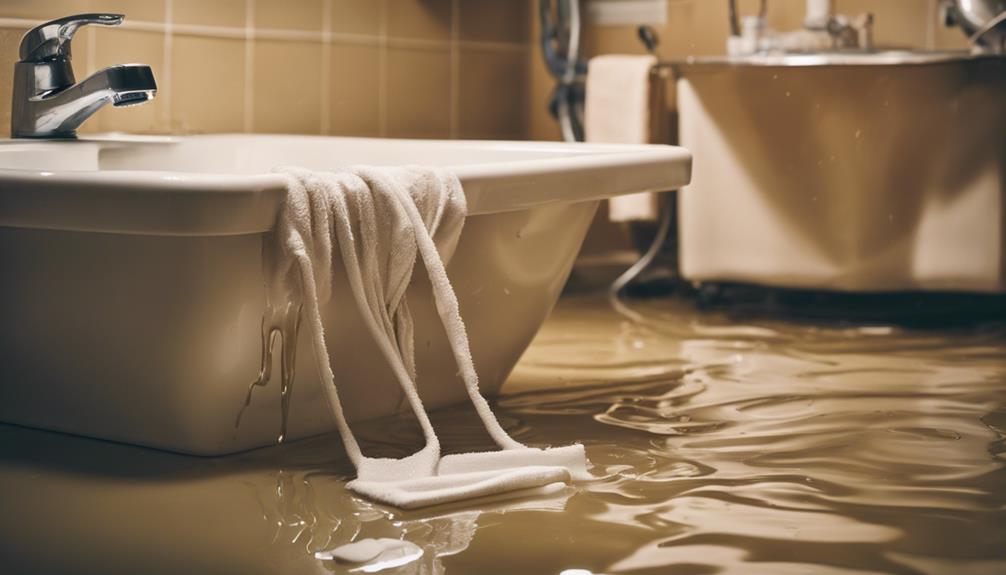
Once you've stopped the water flow, it's crucial to assess the damage right away.
Contact your insurance company to report the incident and document everything thoroughly for your records.
This proactive approach will help you navigate any claims and ensure you're protected from further loss.
When faced with water damage caused by a plumber's mishap, it's crucial to act swiftly to prevent further issues.
Start by assessing the immediate impact of the situation. Here's what you should do:
Additionally, move any salvageable items to a dry location and use towels or a wet/dry vacuum to remove standing water.
By taking these steps, you'll not only minimize the damage but also create a clear record of the incident, which might be helpful later on.
Acting quickly can save you from more extensive repairs down the line.
Water damage can be overwhelming, but contacting your insurance company promptly is essential to prevent further complications.
Start by reaching out to your homeowners or renters insurance to report the water damage caused by the plumber. Make sure to provide them with all relevant details, including the plumber's contact information.
It's crucial to inquire about the specific coverage for water damage in your policy, as these details can vary, especially concerning contractor-related incidents.
Once you've reported the damage, follow the guidance provided by your insurance company. They'll instruct you on how to proceed with filing a claim and any necessary water damage restoration steps.
Keep a detailed log of all communications with your insurance provider, such as dates, times, and the names of representatives you speak to. This log will help you track the progress of your claim and ensure that you have a clear record of your interactions.
An insurance adjustor will likely visit to assess the damage, so being prepared with documentation can only strengthen your case. Taking these steps will help you navigate the process efficiently and minimize further damage to your home.
After contacting your insurance company, it's time to focus on documenting everything thoroughly to prevent further damage.
This documentation will be vital for your claims process and any potential disputes with the plumber.
Here's how to ensure you have solid evidence of the damage:
In the wake of water damage caused by a plumbing mishap, calling a restoration professional is crucial for minimizing further issues.
An experienced restoration contractor can provide a quick response to mitigate the damage, ensuring that your property doesn't suffer more than necessary. They utilize specialized equipment for effective water extraction and drying, significantly reducing the risk of mold growth.
These professionals are trained in water mitigation techniques, allowing them to preserve salvageable materials while safely removing those that are unsalvageable.
Their expertise not only helps in restoring your property but also adheres to industry standards and protocols, which can be vital for your insurance claims.
Engaging a restoration company can facilitate smoother communication with your insurance provider, as they'll provide necessary documentation and assessments.
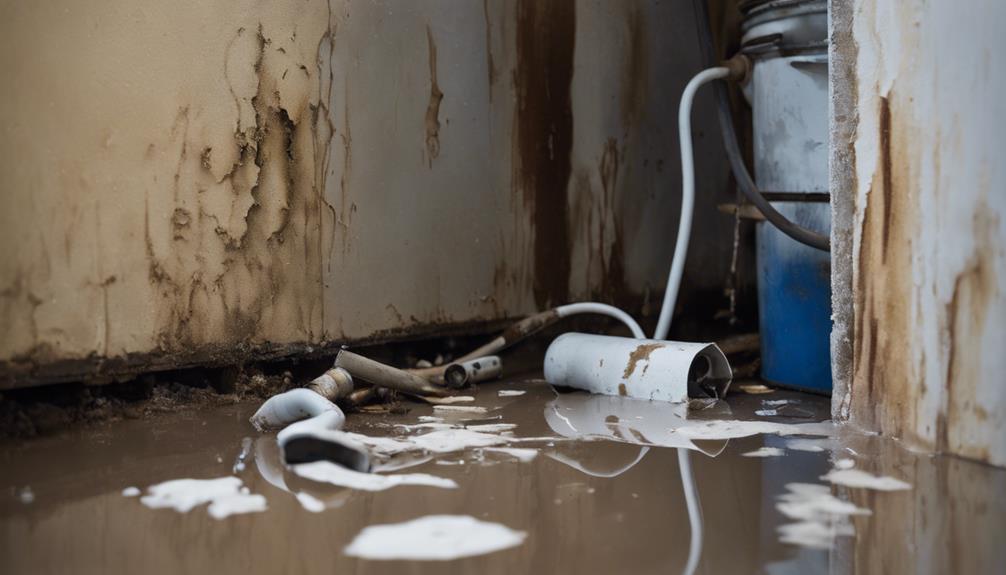
Understanding your rights as a homeowner is essential when dealing with water damage caused by a plumber's negligence. You might be entitled to compensation through your homeowners insurance policy. Here's what you should consider:
If the job isn't completed satisfactorily or damage occurs, you have grounds for disputing payment or even pursuing legal action.
Knowing your rights and taking proactive steps can help you navigate this challenging situation effectively.
Knowing your coverage is vital when dealing with water damage from a plumber's negligence. Your homeowners insurance typically covers such damage, but it's essential to review your policy specifics to understand the extent of your coverage. This includes repair costs, cleanup, and restoration expenses, which depend on the terms outlined in your policy.
Be aware that some policies may exclude damage resulting from poor workmanship. This makes it crucial to verify your coverage limits with your insurance agent. Regularly reviewing your homeowners insurance policy ensures you have adequate protection against incidents caused by contractors.
In addition to understanding your policy, it's a good idea to document all communications and details of the damage before filing a claim. This documentation will help facilitate the claims process and provide necessary evidence to your insurance provider.
If the plumber has contractor liability insurance, it may also be beneficial to explore that avenue for compensation. Ultimately, knowing your coverage can make a significant difference in how you handle water damage and any financial implications that arise.
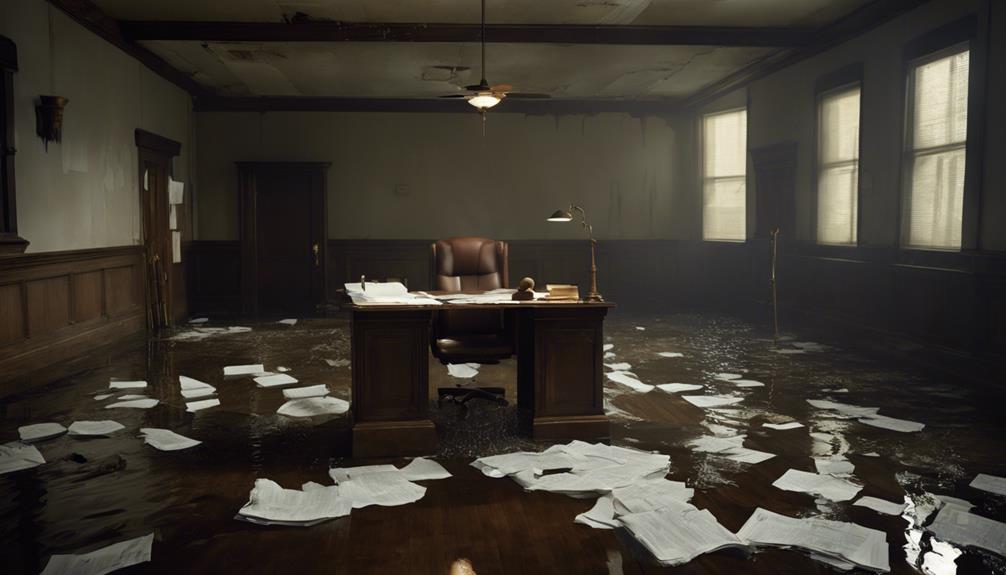
When dealing with water damage caused by a plumber, seeking legal advice is crucial for protecting your rights and exploring potential claims against the contractor. Consulting a legal professional can help you understand the complexities surrounding contractor liability insurance and your homeowners insurance coverage.
Here are some key steps to take:
After addressing the legal aspects of water damage caused by a plumber, the next step is ensuring you hire a reputable professional for any future plumbing needs.
Start by researching potential plumbers in your area. Check online reviews, ratings, and referrals to gauge contractors' reputations. A solid reputation often indicates quality work and reliability.
It's crucial to verify information about the plumber you're considering. Confirm they carry adequate liability insurance and workers' compensation insurance. This coverage protects you from potential damages or injuries during the job.
Don't hesitate to request and review their credentials, including licenses and certifications, to ensure their qualifications are legitimate.
Before any work begins, ask for a detailed estimate outlining all costs involved. This step helps avoid unexpected expenses and ensures clarity on the scope of services provided.
When a plumber makes a mistake, like negligent plumbing, it can lead to serious issues, including leaks and water damage.
You might face liability issues if the damage is extensive. It's crucial to understand your homeowner rights; you could file insurance claims to cover repair costs.
Document the damage and consider preventative measures for the future. Open communication with the plumber may help resolve the situation before escalating it further.
Yes, water damage can be fixed in your house.
The restoration process typically involves water extraction, drying, and repairs to affected areas. You should consider professional services, as they use specialized equipment for thorough drying.
Don't forget to review your homeowner rights; insurance claims might cover some costs, especially if negligence is involved.
Also, remember to follow prevention tips to avoid future issues, ensuring your home stays safe and dry.
To fix water pipe damage, start by using effective pipe repair techniques.
Shut off the water supply and assess the damage.
Employ water extraction methods to remove excess moisture, followed by drywall replacement tips if needed.
Implement mold prevention strategies to safeguard against future issues.
Document everything for the insurance claim process, and ensure you maintain your plumbing system regularly to prevent future leaks.
With these steps, you can restore your home efficiently.
Yes, a broken pipe can definitely cause significant water damage.
When you experience pipe leaks, it's crucial to act quickly. Water restoration efforts can prevent further property damage and reduce repair costs.
Contact an emergency response team to address the leak immediately. Remember, plumbing insurance often covers these incidents, but you'll need to document everything for a successful claim.
Don't wait too long, as mold can develop within days!
When a plumber causes water damage, it's crucial to act quickly. Assess the situation, document everything, and reach out to your plumber and insurance company right away. Don't forget to prevent further damage and know your rights. Understanding your coverage can save you a lot of stress, and if necessary, seek legal advice. Lastly, for future plumbing needs, always hire a reputable plumber to avoid similar issues. Take these steps, and you'll be on your way to recovery.
Basement water damage in Sherman Oaks can happen quickly, especially during heavy rains. It's important to act fast to prevent further issues, like mold growth or structural damage. You should check your basement regularly for signs of moisture and ensure drainage systems are clear. Professional help is available from IICRC certified technicians who can assess the damage and recommend targeted restoration solutions. They use advanced equipment to effectively remove water and minimize future risks. Taking proactive steps now can safeguard your home. There's plenty more to discover about how to manage water damage effectively.
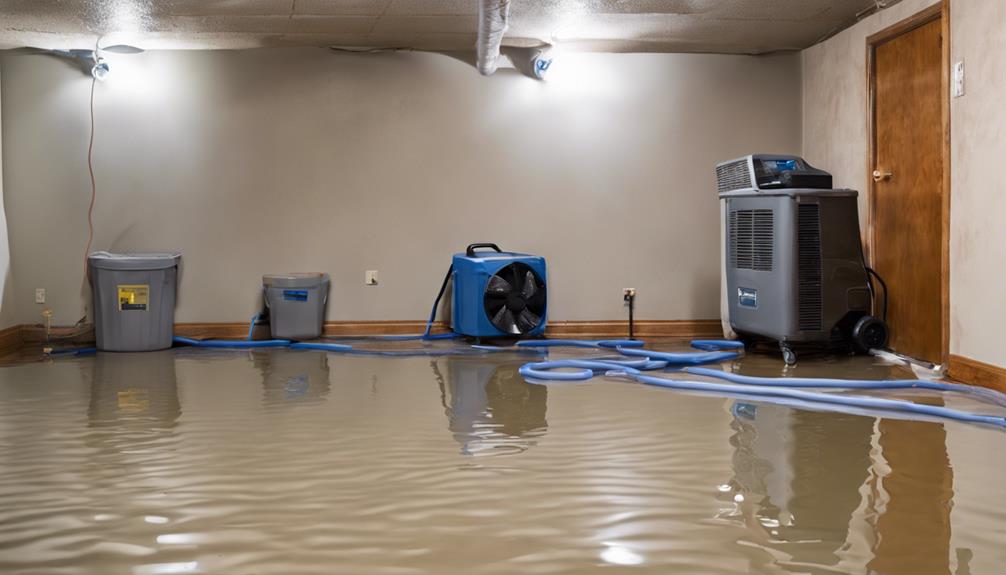
At First To Respond Restoration, we understand the stress and urgency that comes with water damage in your basement, which is why we offer 24/7 emergency services in Sherman Oaks.
Our team of IICRC certified restoration technicians is dedicated to providing you with immediate assistance, conducting thorough assessments to identify the extent of the damage and implementing tailored solutions to meet your specific needs.
Timely restoration prevents long-term damage to your property, and we utilize advanced water extraction equipment that effectively removes standing water.
Additionally, we provide sump pump installation and drainage systems that prevent future issues, ensuring your home is restored to its pre-loss condition.
Furthermore, our comprehensive mold remediation services address any health hazards linked to moisture buildup, creating a safe environment for you and your family.
We also assist you in navigating the insurance claims process, providing the necessary documentation and support to secure coverage for your repairs, so you can focus on getting your life back to normal.
At WDLA, we provide complete water damage restoration services right here in Sherman Oaks, ensuring your basement is safe and dry.
Our experienced technicians are skilled in professional expertise to handle everything from water removal to mold remediation, so you can feel secure in your home again.
We're here 24/7, ready to respond quickly to any emergency and help you get back on track.
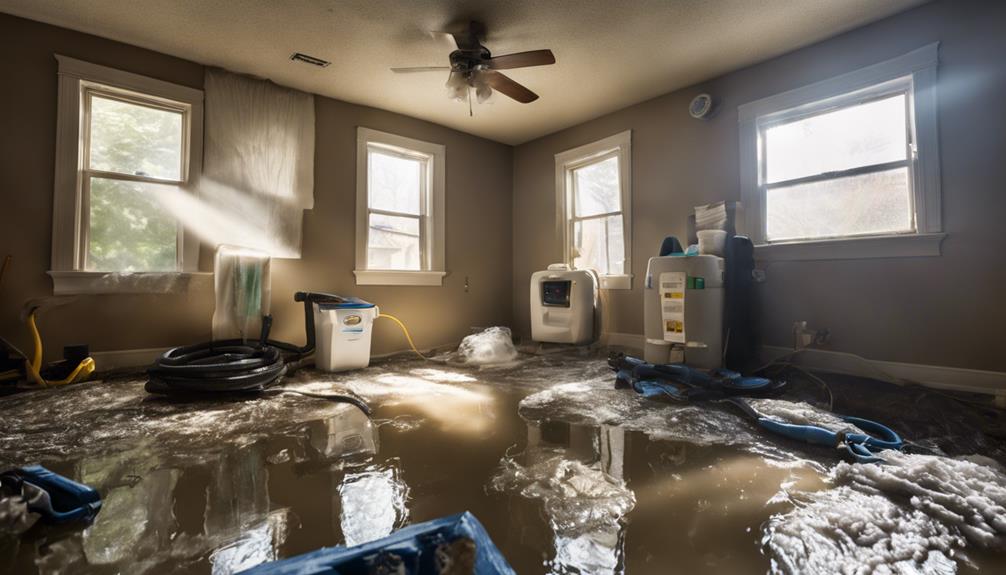
When disaster strikes your home or business in Sherman Oaks, WDLA – Water Damage Los Angeles is ready to provide complete water damage restoration services tailored to your needs.
Our team specializes in addressing various issues, including flood damage repair, burst pipes, mold remediation, and sewage cleanup. We understand how stressful Sherman Oaks water damage can be, and that's why we're here to help.
Our experienced and certified technicians use state-of-the-art equipment to quickly assess and address the damage, ensuring your property is safe and secure.
We collaborate with your insurance provider for direct billing, making the process smoother for you.
Our customer-centric approach means we prioritize your needs throughout the restoration process. We know that time is of the essence when it comes to water damage, and we're committed to acting swiftly to restore your home.
With WDLA, you can expect professionalism and a reliable team ready to tackle any challenge.
Don't let water damage disrupt your life; contact us today to learn more about our comprehensive water damage restoration services and how we can help you restore your home.
Call us at (323) 825-3485.
Water damage can strike unexpectedly, and knowing the right services to call on can make all the difference. At WDLA – Water Damage Los Angeles, we offer comprehensive water damage restoration tailored to your needs.
Whether it's a minor leak or a major flood, our experienced team is ready to help restore your Sherman Oaks property.
Our services include:
With 24/7 emergency services, we're always on call to ensure you get the immediate assistance you need.
Our state-of-the-art equipment and certified technicians guarantee effective water cleanup, so you can trust that your property is in good hands.
Plus, we work directly with your insurance, making the process smoother for you.
Don't let water damage linger—reach out to WDLA for reliable, professional service you can count on. Call us at (323) 825-3485 today!
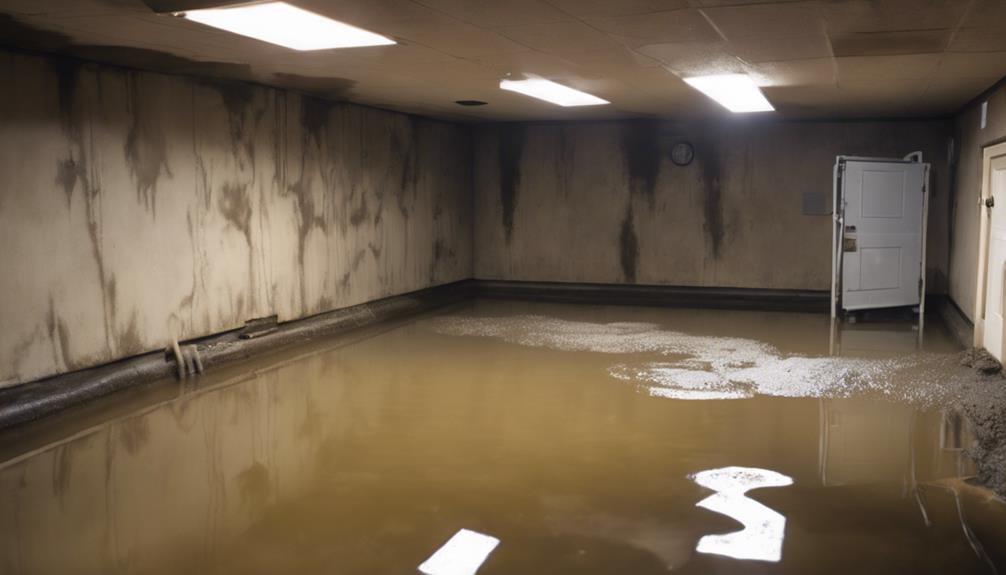
If you're facing water damage in your home, WDLA – Water Damage Los Angeles is here to help. Based in Sherman Oaks, this company specializes in comprehensive water damage restoration services, including emergency flood cleanup and mold remediation.
Their team consists of IICRC certified technicians, ensuring that you receive high-quality service. With their expertise in various water damage scenarios, they can effectively handle the water damage restoration process from start to finish, minimizing downtime and preventing further issues.
WDLA offers 24/7 emergency response services, which means you can get prompt assistance when unexpected water intrusion occurs. They utilize advanced techniques such as moisture detection, water removal, and structural drying to restore your property to its pre-damage condition.
Moreover, WDLA is committed to educating homeowners about water damage prevention, helping you understand how to protect your home in the future. They also provide free estimates for restoration work, allowing you to make informed decisions without any pressure.
With a reputation for professionalism and a customer-centric approach, WDLA aims to make the restoration process as smooth as possible for you.
When you need reliable water damage restoration services in Sherman Oaks, you can count on WDLA to act quickly and effectively. Your peace of mind is their priority.
Protect your home and peace of mind—schedule your free consultation today to uncover the hidden risks of basement water damage in Sherman Oaks!
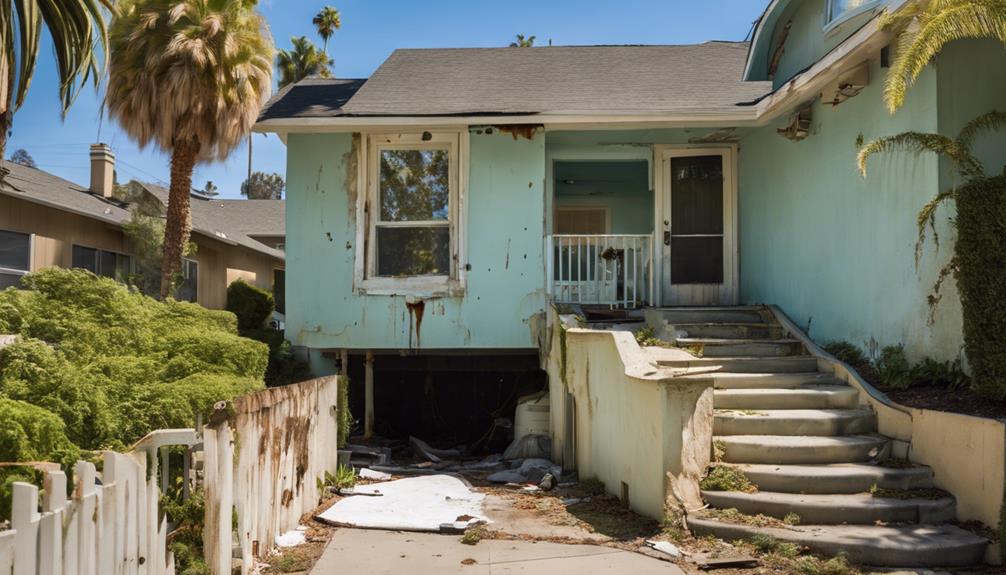
Sherman Oaks offers a blend of attractions and neighborhoods that make it a unique place to live.
You can explore parks and enjoy the Mediterranean climate, which brings warm summers and mild winters, but also the risk of seasonal water issues.
As you consider the best sights and neighborhoods, keep in mind how the weather can impact your home, especially if you have a basement.
Nestled in the heart of the San Fernando Valley, Sherman Oaks offers a delightful blend of natural beauty and urban charm. One of the best sights to visit is Van Nuys-Sherman Oaks Park. This expansive park features sports fields, walking trails, and picnic areas, making it perfect for outdoor activities.
If you're in the mood for shopping or dining, head over to the Sherman Oaks Galleria. This vibrant destination has a mix of retail stores, restaurants, and entertainment options that cater to everyone.
For history buffs, the iconic Sherman Oaks Castle stands as a remarkable landmark, showcasing the area's architectural charm. You'll also appreciate the diverse culinary scene, with eateries ranging from trendy cafes to upscale dining experiences, reflecting the community's multicultural influences.
Moreover, Sherman Oaks is conveniently located near major attractions in Los Angeles, like the Hollywood Hills and Universal Studios, allowing you to explore the greater region easily.
Whether you're enjoying a peaceful day at the park or indulging in delicious food, Sherman Oaks has something for everyone while enhancing your experience with the best sights to visit.
When it comes to finding the best neighborhoods in Sherman Oaks, you'll discover a variety of options that cater to different lifestyles and preferences. Sherman Oaks features a mix of single-family homes, townhouses, and apartments, making it appealing to many residents.
If you're looking for a family-friendly environment, you'll appreciate the excellent schools and parks available, perfect for parents focused on quality education for their children.
The neighborhood's convenient location near the 101 and 405 freeways provides easy access to downtown Los Angeles and surrounding areas, which is great for commuting. Along Ventura Boulevard, you'll find a vibrant dining and shopping scene, offering plenty of entertainment and leisure activities right at your doorstep.
Moreover, Sherman Oaks boasts a strong sense of community. Local events and farmers' markets foster connections among residents, enhancing the neighborhood's charm.
However, it's wise to be aware of potential water damage issues, especially in basements, as they can affect your home. If you ever face such challenges, consider reaching out to professionals like WDLA – Water Damage Los Angeles for assistance. Their expertise can help restore your home and ensure it stays a wonderful place to live.
Understanding the seasonal weather in Sherman Oaks is vital for homeowners, especially when considering the potential impact on properties. This region has a Mediterranean climate, featuring hot, dry summers and mild, wet winters.
You can expect about 18 inches of rainfall annually, with most of it falling between November and March. During this winter period, heavy rains and occasional storms can significantly increase the risk of basement water damage.
As temperatures rise to the mid-90s°F in summer and drop to the mid-40s°F during winter nights, it's essential to be proactive. These temperature fluctuations can create conditions that exacerbate water issues if not properly managed.
To prevent water damage in your basement, it's crucial to implement effective waterproofing measures. Regularly check your drainage systems and seal any cracks in your foundation, especially before the rainy season hits.
If you're facing basement water damage in Sherman Oaks, don't hesitate to reach out to WDLA – Water Damage Los Angeles. Their expert team is ready to assist you 24/7, ensuring your home is restored quickly and efficiently. With their advanced equipment and commitment to customer satisfaction, you can feel confident that your needs are a priority. Remember, timely action can prevent further issues, so call WDLA today and take the first step towards restoring your basement.
If you're dealing with water damage, it's crucial to act fast. Call a professional restoration service like SERVPRO, as they specialize in water damage and offer 24/7 emergency assistance. You might also contact a licensed plumber to address any leaks or plumbing issues. If structural damage is evident, a skilled carpenter can help with repairs. Don't forget to notify your insurance company to understand your coverage. The longer you wait, the more severe the damage can become, so swift action is essential. There's more to know about the restoration process and prevention tips.
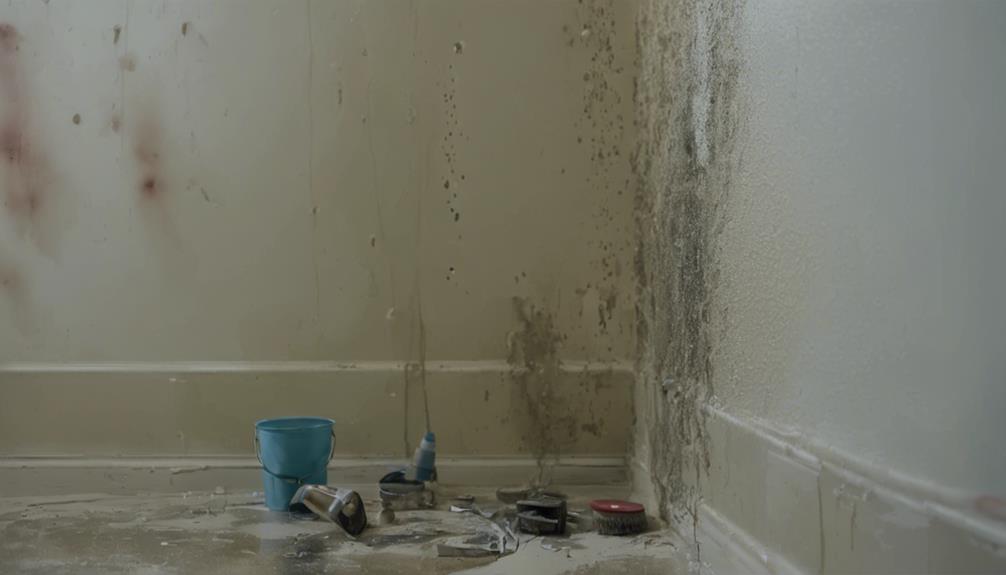
Water damage can strike unexpectedly, and understanding its risks is essential for any homeowner. Various sources of water, like burst pipes, overflowing sinks, or roof leaks, can lead to significant structural issues within just 24 hours if you don't act quickly. Ignoring these problems can result in costly repairs and a loss of property integrity.
It's important to recognize that insurance coverage for water damage can vary, and knowing how your policy works can make a significant difference in your recovery process. One of the most alarming consequences of untreated water damage is mold growth. Mold can develop rapidly and pose serious health hazards, including respiratory issues and skin irritations.
To prevent mold, it's crucial to address water damage immediately. You should consider seeking professional help to assess the situation accurately. They can identify the source of water damage and determine the extent of the impact on your property, ensuring a proper water damage restoration plan.
It's also vital to be aware of your insurance claims. Many policies may cover sudden, accidental damages but often exclude maintenance-related issues. Understanding your coverage can save you from unexpected out-of-pocket expenses.
Noticing early signs of water damage, like leaks or stains, should prompt you to act fast. Your first step is to turn off the water supply to prevent further issues.
Then, it's time to call a plumber. Professional plumbers have the expertise to identify the source of the problem quickly. Whether it's a burst pipe or a persistent leak, they can handle water damage repair effectively, minimizing potential structural damage to your home.
Ignoring plumbing issues can lead to serious complications, including mold growth and skyrocketing repair costs. If you try to tackle these repairs on your own, you might make things worse, resulting in even higher expenses.
Hiring a licensed plumber ensures that repairs are done properly and safely. Comprehensive plumbing services can address various issues, from fixing leaky pipes to unclogging drains.
Companies like Mr. Rooter Plumbing even offer free plumbing checkups, which can help you maintain system efficiency and catch problems before they escalate.
Don't wait until it's too late—when you spot the signs of water damage, reach out to a professional to restore your home swiftly and effectively.
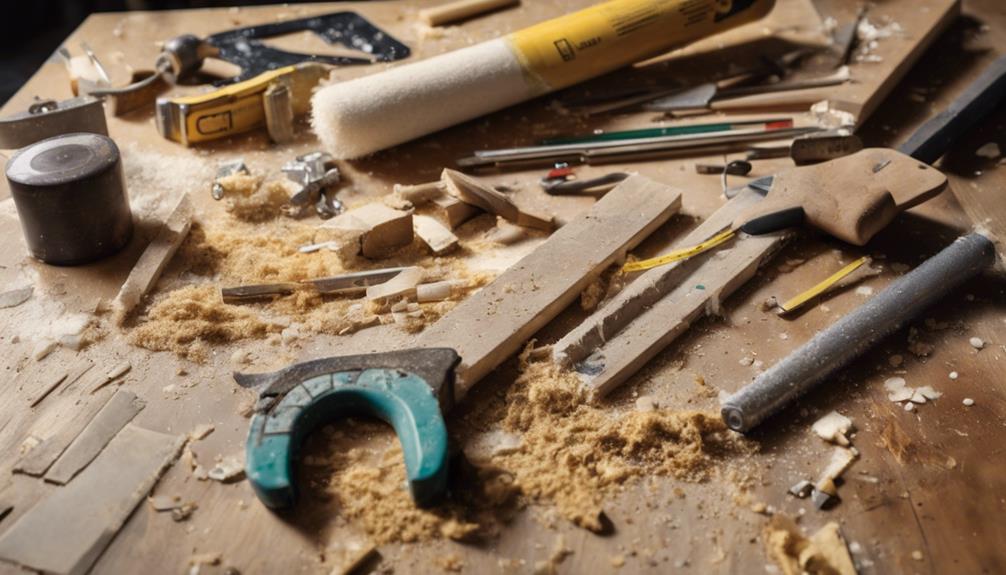
After addressing the plumbing issues, you'll need a skilled carpenter to tackle the structural damage that may have occurred.
Carpenters play a crucial role in the repair services that follow water removal, ensuring your home's integrity is restored. They assess the extent of damage to walls, flooring, and roofs, determining which materials need replacement and which can be salvaged.
A carpenter's expertise involves measuring, cutting, and fastening materials to restore these vital structures. They interpret blueprints and often collaborate with plumbers and electricians, ensuring a comprehensive approach to the restoration process.
This teamwork is essential for addressing any underlying issues caused by the water damage.
While there's no specific certification required to become a carpenter, their diverse skill sets and practical experience in construction make them invaluable during recovery.
After water damage, you want someone who understands the nuances of repair and can execute the necessary work efficiently. By hiring a qualified carpenter, you ensure that your home not only looks good after repairs but is also safe and structurally sound for the future.
When you face water damage, choosing SERVPRO for restoration means accessing comprehensive services tailored to your needs.
Their advanced equipment and trained professionals ensure that your property gets the thorough care it requires.
With SERVPRO, you can trust that your restoration process will be efficient and effective.
Choosing the right restoration service can feel overwhelming, especially when you're dealing with water damage. That's why SERVPRO stands out as the #1 choice in cleanup and restoration. With over 50 years of experience and more than 2,000 franchises across the U.S. and Canada, they know how to tackle the problem effectively.
Here are a few reasons to consider SERVPRO for your restoration needs:
When you face water damage from a leak or flooding, SERVPRO's trained professionals will assess the water source and act swiftly, minimizing further damage.
Their approach encompasses everything necessary for restoring your home to its pre-loss condition, ensuring that repairs are handled efficiently and safely. You can trust SERVPRO to manage your cleanup and restoration needs with professionalism, making your experience as stress-free as possible.
With their dedication to high-quality service, you'll feel confident that your home is in good hands.
SERVPRO's commitment to effective restoration goes beyond excellent customer service; it also includes the use of advanced equipment that sets them apart in handling water damage.
Their professional teams utilize industrial-grade dehumidifiers and air movers to efficiently dry out affected areas, significantly reducing the risk of mold growth. This proactive approach is crucial in any restoration process.
When you choose SERVPRO, you're selecting experts equipped with advanced extraction tools, such as truck-mounted water extractors, designed to remove large volumes of standing water quickly and effectively.
Their teams are also trained to identify hidden damage using moisture meters and thermal imaging cameras, ensuring no issues are overlooked.
Additionally, SERVPRO employs specialized cleaning agents and antimicrobial treatments to sanitize and deodorize affected areas, promoting a safe environment after restoration.
Adhering to industry standards and best practices, they guarantee that all processes are performed efficiently and in compliance with local regulations.
This holistic approach to water damage restoration means you can trust SERVPRO to restore your property to its pre-loss condition while ensuring the safety and comfort of your space.
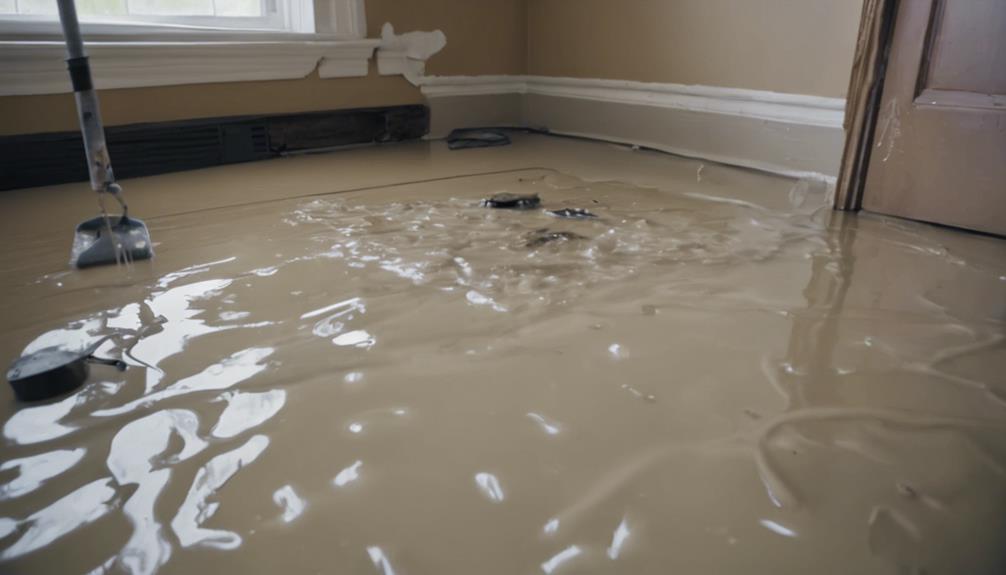
Water damage can be overwhelming, but taking immediate action can significantly reduce its impact. Start by assessing the situation and following these crucial steps:
If you find hidden water or suspect mold and mildew, it's essential to act quickly.
Initiate restoration efforts within 24-48 hours to minimize risks. If you need assistance or advice on how to fix a water leak, don't hesitate to contact us.
Taking these initial steps can help prevent further complications and keep your home safe.
Taking swift action after water damage is vital for protecting your property and health. Timely action can make all the difference in preventing further damage and minimizing repair costs.
When water damage occurs, delays can escalate the situation beyond repairable limits, leading to significant financial burdens.
Mold can start to grow within just 24-48 hours of water exposure, posing serious health risks to you and your loved ones. Immediate professional intervention is crucial to combat mold and ensure a safe living environment.
By reaching out to experts who operate 24/7, like SERVPRO, you're ensuring a quick response that mitigates damage and restores your property to its pre-loss condition.
Acting promptly not only reduces the duration of restoration efforts but also significantly cuts down on overall costs. Remember, every hour counts when dealing with water damage.
If you fail to address the issue quickly, you risk serious health issues, including respiratory problems and skin irritations caused by mold and bacteria.
Don't wait—take action now to protect your property and well-being.
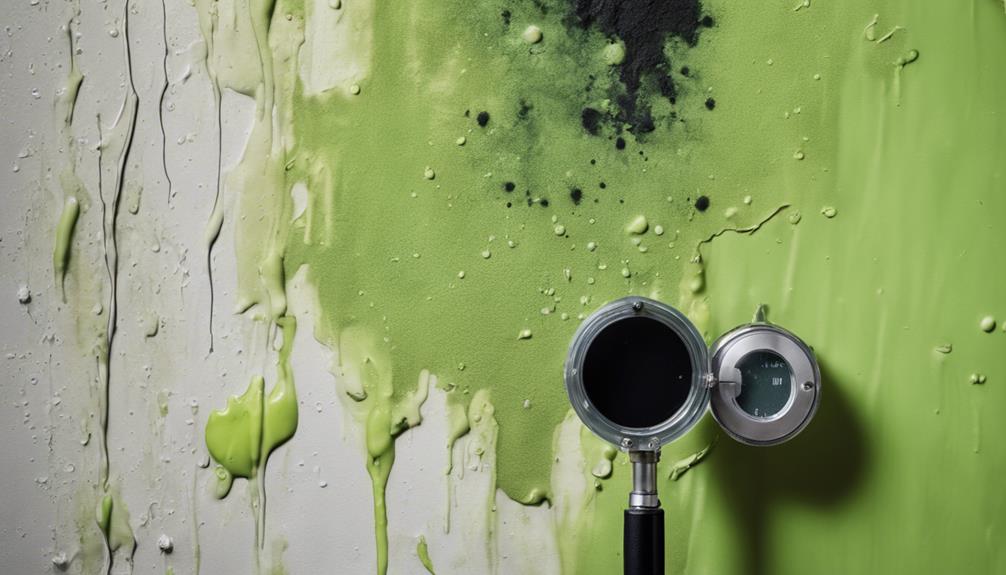
Mold can be a sneaky intruder in your home, often going unnoticed until it's too late. After water damage, mold can start developing within 24-48 hours, making prompt action essential.
To effectively identify and prevent mold growth, consider these key strategies:
When you act fast, you significantly reduce the risk of mold proliferation. During the drying process, be careful not to spread mold spores by mishandling wet items.
If you suspect a mold issue, a professional mold assessment is crucial, as dormant spores can pose ongoing health risks.
For thorough mold remediation, look for services that focus on sanitization and deodorization, ensuring any existing mold is removed and future growth is prevented.
By taking these steps, you can protect your home from the hidden dangers of mold, keeping your environment safe and healthy.
When faced with water damage, understanding the restoration process can make a significant difference in how quickly your home returns to normal. The first step involves thorough assessment to identify the extent of damage. Restoration professionals will evaluate the situation and create a tailored plan for your property.
Next, water extraction is crucial. They'll remove standing water using advanced equipment, ensuring the area is cleared effectively.
Following that, drying is essential. Restoration companies deploy dehumidifiers and air movers to reduce moisture levels, preventing mold after water exposure. This step typically needs to be completed within 24 to 48 hours to avert further complications.
Once everything is dry, the cleaning begins. This encompasses sanitizing affected areas and belongings.
Finally, the last phase involves the steps to repair damaged structures, which can vary in timeline, taking anywhere from a few days to several weeks, depending on the severity of the damage.
Throughout this process, you'll likely need to document everything for your insurance company, including photographs and a list of affected items, to ensure you receive accurate coverage for your water damage restoration.
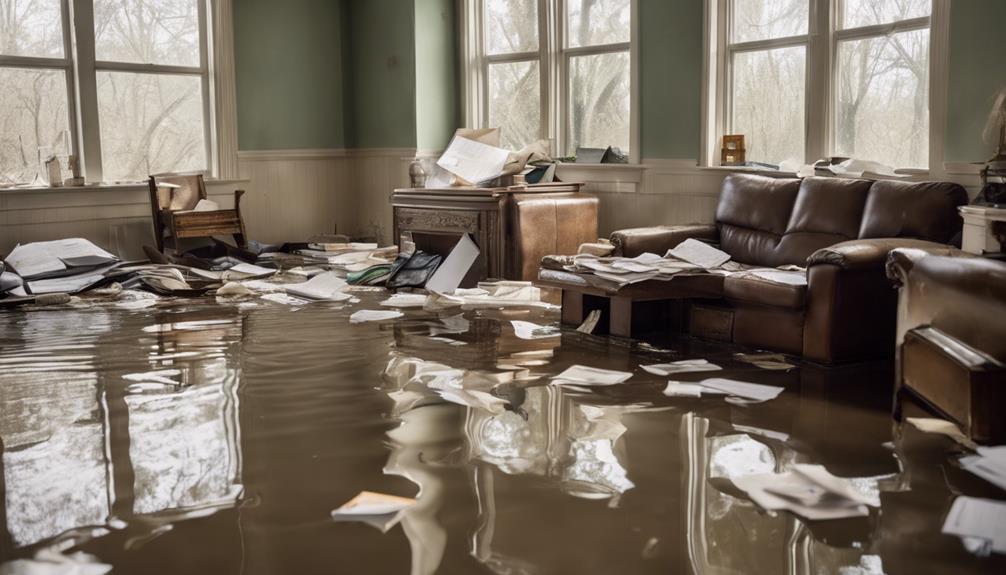
When water damage strikes, understanding your insurance coverage is vital.
You'll want to know what types of water damage your policy covers and the claims process to ensure you're prepared.
Let's break down these coverage types and what you need to do to file a claim successfully.
Understanding your coverage options is crucial for homeowners facing water damage, as policies can vary significantly.
You'll want to familiarize yourself with the different coverage types to ensure you're adequately protected. Here are some key points to consider:
Make sure to consult your insurance agent to fully grasp your coverage limits, deductibles, and any specific exclusions related to water damage.
The claims process for water damage can feel overwhelming, but knowing what to expect makes it easier to navigate. Your first step is to contact your insurance company to verify coverage and understand the specifics of your policy.
Typically, policies cover sudden and accidental water damage, like burst pipes, but they may exclude damages caused by neglect or maintenance issues.
To streamline the claims process, it's crucial to document damage thoroughly. Take photos of affected areas and keep a record of all communications with your insurance provider.
This documentation will support your claim and help clarify any disputes.
After water damage, you should act quickly.
Start by turning off the power to affected areas for safety. Next, make emergency contacts, like your insurance company, to begin a damage assessment.
Document everything with photos for your insurance claims. Elevate furniture and remove wet items to prevent further damage.
Then, initiate drying techniques and reach out to restoration services within 24-48 hours to minimize mold growth and structural issues.
When assessing how much water damage is too much, you need to act quickly.
If you see water pooling over an inch or notice mold growth within 24-48 hours, it's serious.
For extensive damage affecting multiple rooms, consider restoration services immediately.
Document everything for insurance claims, and don't wait to implement prevention methods.
When dealing with water damage, costs can vary based on several factors.
A water damage assessment helps determine the extent of the damage, influencing restoration services' pricing, which averages between $3 to $8 per square foot.
Insurance claims can significantly reduce your out-of-pocket expenses, but be aware of policy exclusions.
To minimize costs, consider prevention tips like regular maintenance and quick leak repairs.
Don't underestimate the potential for mold remediation costs, either.
To know if you have water damage under your floor, look for signs of dampness like warped floorboards or soft spots.
Use floor inspection techniques, such as tapping on boards, to check for hollow sounds.
Moisture assessment tools can help identify hidden leaks.
Don't ignore musty odors or visible mold; they're clear indicators.
For future issues, follow a preventive measures guide to protect your home from water damage.
Stay vigilant!
When you face water damage, acting quickly is key. Don't hesitate to call a plumber for immediate leaks, and consider reaching out to a carpenter for structural repairs. Choosing a restoration service like SERVPRO can help bring your home back to normal. Always keep an eye out for mold and address it promptly. Remember, understanding your insurance coverage can ease the financial burden. With the right steps, you can tackle water damage effectively and protect your home.
If a water main breaks and causes damage to your property, understanding who's responsible isn't always straightforward. Generally, homeowners are accountable for their service lines, while municipalities handle repairs to the main water supply. This means you might bear the costs for damages if the break occurs on your property. Promptly reporting the incident to local authorities is crucial, as the municipality may be liable if the break is due to negligence or aging infrastructure. Knowing your insurance coverage is also essential, as many policies exclude such damages. There's more to uncover regarding responsibility and potential compensation options.
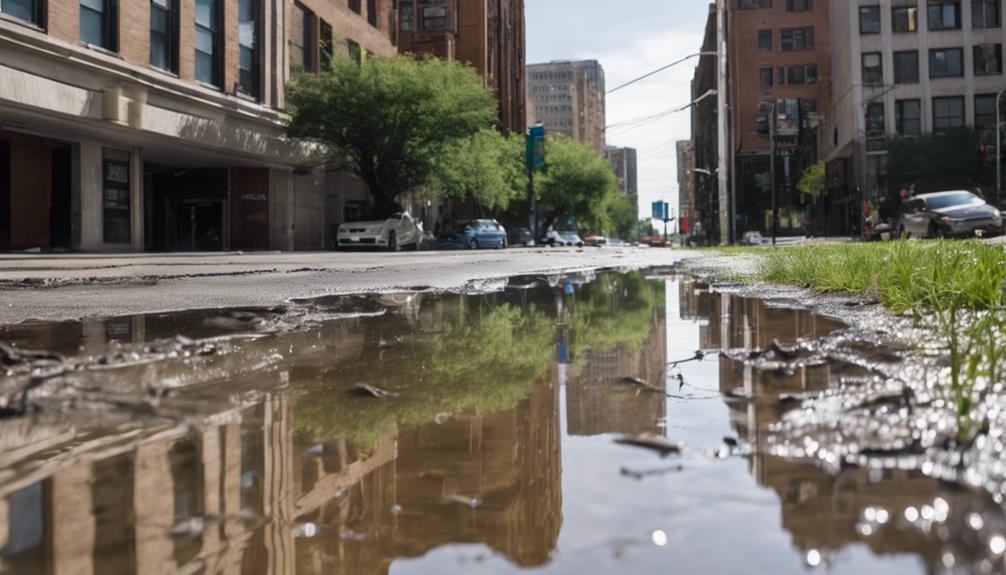
Water main breaks can wreak havoc on communities, causing significant disruption and damage. A water main is the primary pipe that carries water underground, while the water service line consists of the smaller pipes connecting that main to your property.
With over 240,000 water main breaks happening annually in the U.S., it's crucial for every property owner to understand their role in this scenario. Homeowners should also be aware of their insurance coverage for water damage, as insurance coverage for water damage can significantly impact their financial responsibility in these situations.
Local municipalities typically handle repairs on public water mains, but as a homeowner, you're responsible for maintaining and repairing the water service lines on your property. When a break occurs, addressing it promptly is vital to prevent further damage to your home and the surrounding area.
Factors like aging infrastructure, environmental conditions, and poor maintenance practices often contribute to these breaks, so staying informed can help you react quickly.
Additionally, you should check your homeowners insurance policies to understand your coverage regarding water service line issues. Knowing what's included can save you from unexpected financial burdens when a water main break affects your property.
Always report breaks to local authorities to ensure swift repairs and minimize damage to personal and public infrastructure.
When a water line breaks, knowing who's responsible for repairs is crucial.
As a homeowner, you'll need to take care of the service line connecting your property to the main, while the municipality handles issues with public water mains.
It's also important to consider how your insurance might cover these situations.
As a homeowner, you're directly responsible for the maintenance and repair of the water service line that connects your property to the main supply. If that line breaks, it's crucial to address the problem immediately to prevent further damage to your property. A broken water main can lead to significant issues if left unattended, including flooding and costly repairs.
You should familiarize yourself with the location of your water service line, as this will help determine your liability if a break occurs. Your responsibility includes not only repairs but also ensuring that you report any water main breaks to local authorities. This way, public repairs can be carried out efficiently.
While homeowners insurance may cover some damages resulting from a broken water main, it's essential to understand the specifics of your policy. Some policies may not include coverage for certain types of water damage, so check to see if your homeowners insurance covers water-related incidents effectively.
Being proactive about your repair responsibilities can save you from future headaches and financial strain.
Municipalities play a crucial role in addressing water main breaks that occur on public property, ensuring the safety and integrity of the water supply system. Under municipal liability, local governments are typically responsible for the repairs needed after such incidents.
Here's what you should know:
When a water main break occurs, it's essential for municipalities to act swiftly to mitigate damages and restore service.
You might wonder how this affects you as a homeowner or business owner. If damage occurs due to a break, understanding municipal liability can help clarify who's responsible for repairs. Knowing your local laws can empower you to seek recourse if you're negatively impacted.
Ultimately, municipalities are tasked with ensuring that public property remains safe and functional for all community members.
Navigating insurance coverage can be daunting for homeowners facing the aftermath of a water main break. Typically, you're responsible for repairs to your private water service lines, while municipalities handle public water main repairs.
Unfortunately, standard homeowners insurance policies often exclude damages caused by municipal water supply issues, leaving you with potentially significant out-of-pocket expenses for repairs.
When assessing coverage, it's crucial to determine the source of the water causing the damage. If the water main break is the culprit, chances are your standard homeowners policy won't cover the resulting water damage.
To mitigate your financial risks, consider optional endorsements or separate flood insurance policies. These can provide additional protection specifically tailored for incidents like water main breaks or flooding events.
Moreover, understanding local regulations and the specifics of your insurance policy can help you navigate potential liabilities effectively.
By familiarizing yourself with what your insurance can and can't cover, you can ensure you have adequate coverage for water damage incidents and avoid unexpected costs.
Always review your policy and consult with your insurance agent for the best protection against water main break damages.
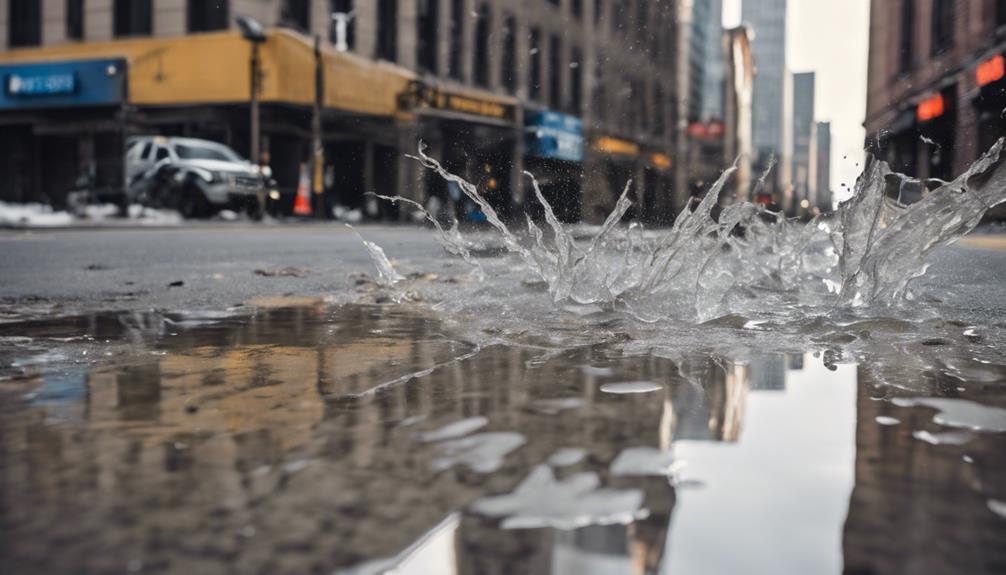
When a water main break occurs, understanding who bears financial liabilities can be complex. Typically, the at-fault party doesn't pay damages directly; instead, insurance companies handle claims from affected property owners. You'll need to assess your situation to determine your options for compensation.
Here are some key considerations regarding financial liabilities:
Since public entities often manage water mains, you could face challenges in proving negligence.
However, if you gather the right evidence and possibly seek legal assistance, you can maximize your chances of receiving compensation for the damage.
Understanding these financial liabilities is essential, as they'll impact your recovery process after a water main break.
Don't hesitate to consult professionals to help you through this intricate landscape.
When it comes to water main breaks, several key factors play a role.
You might notice that aging infrastructure can lead to increased failures, while environmental conditions can shift soil and disrupt pipes.
Additionally, improper maintenance and installation practices can further compromise the integrity of your water system.
Extreme weather variations play a crucial role in the frequency of water main breaks. These environmental factors can lead to soil shifts, which put pressure on the pipes and increase the risk of breaks.
When you consider how various conditions impact water mains, the picture becomes clearer:
Corrosion is another significant issue, with aging infrastructure making older pipes more susceptible to deterioration.
Additionally, high water flow demands can raise pressure within the system, further increasing the likelihood of breaks.
Improper installation adds another layer of vulnerability, as misaligned or poorly supported water mains are at greater risk.
Aging infrastructure poses significant challenges for water main reliability, especially when paired with environmental stressors. Many water pipes, installed decades ago, have deteriorated due to corrosion and material fatigue. This issue is critical, as over 240,000 water main breaks occur annually in the U.S., according to the Environmental Protection Agency. These breaks illuminate the urgent need for regular maintenance and upgrades to aging pipelines.
The lifespan of a water main can vary greatly depending on its material. For instance, cast iron pipes typically last 50 to 100 years, while newer materials may offer greater durability. Unfortunately, many older systems are susceptible to environmental factors like soil shifts, extreme weather, and ground movement. These conditions increase pressure on aging systems, leading to a higher risk of breaks.
Additionally, insufficient maintenance and delayed inspections can accelerate the deterioration of these water mains. When regular upkeep isn't prioritized, the likelihood of sudden failures rises, causing damage that can affect communities significantly.
Addressing these aging infrastructure challenges is essential to mitigate the impact of water main breaks on public safety and property.
Maintenance and installation issues play a critical role in the occurrence of water main breaks. When you consider the condition of water pipes, you'll notice that aging infrastructure and improper practices contribute significantly to these failures.
Here are some key factors to keep in mind:
Regular maintenance is crucial to catch issues early and prolong the life of water mains.
When installation isn't done correctly, it sets the stage for future problems. By addressing these maintenance and installation concerns, you reduce the risk of breaks and the costly damage that follows.
It's important for municipalities and utility companies to prioritize proper practices to ensure the reliability of water infrastructure. Ultimately, proactive measures can save everyone from the headaches associated with water main breaks.
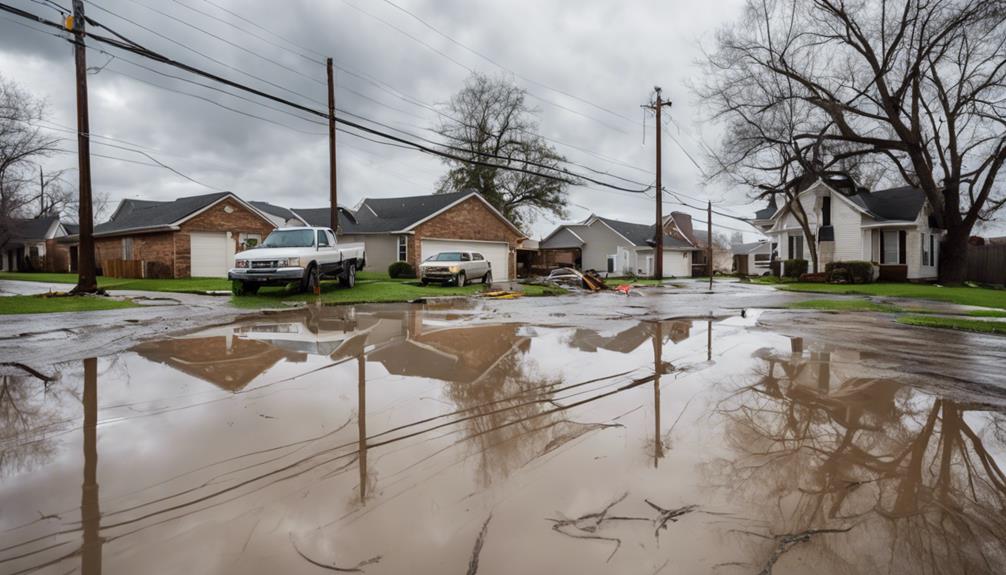
When a water main breaks, the aftermath can be devastating, with consequences ranging from structural damage to the loss of personal belongings. As a homeowner, it's crucial to understand the types of damages you might face.
| Type of Damage | Description | Potential Costs |
|---|---|---|
| Structural Damage | Compromised integrity of your property due to water saturation. | High due to repairs and inspections. |
| Personal Belongings | Destruction of furniture, appliances, and treasured items. | Costs can add up quickly. |
| Indirect Costs | Expenses for temporary housing and additional living needs. | Can be substantial during repairs. |
These damages can lead to significant financial burdens, especially since standard homeowners insurance typically doesn't cover losses from water main breaks. You could find yourself facing out-of-pocket expenses for repairs and replacements. Understanding these potential damages is essential for taking the right steps post-incident and ensuring you're prepared for any financial implications that may arise from such a crisis.
Understanding your insurance coverage is crucial for protecting yourself against the financial fallout of a water main break. Many standard homeowners insurance policies don't cover damages from municipal water supply issues, as these are classified as external damages. This means you might face significant out-of-pocket expenses for repairs if a water main breaks near your home.
To navigate this complex situation, consider these key points:
To safeguard your property, take the time to review your policy and explore additional coverage options.
Water main breaks can lead to costly repairs, and being proactive about your insurance coverage can make all the difference in managing potential financial burdens.
Don't wait until it's too late—ensure you have the right protections in place.
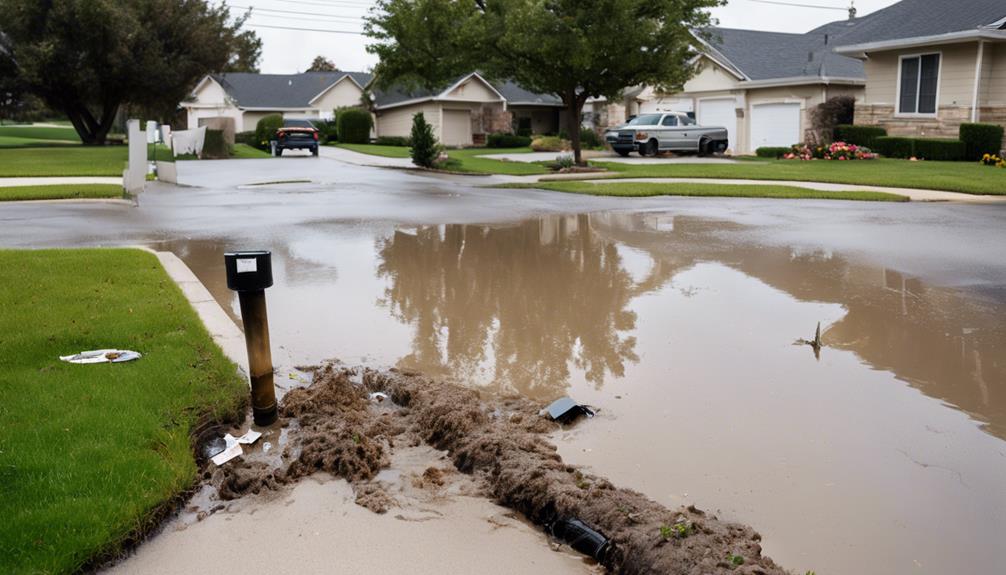
After reviewing your insurance coverage, it's time to take action if you suspect a water main break has affected your property.
First, assess the damage by inspecting your home for signs of water line breaks, such as low water pressure or cracks in the foundation. The sooner you identify these issues, the better you can protect your home.
Next, contact your local water utility company immediately to report the break. They're responsible for water main issues and will need to address the problem.
While you wait for them to respond, document all damages with photos. Keep receipts of any repairs, as this information is crucial for potential insurance claims.
It's also wise to hire a licensed plumber to handle repairs. They can provide a professional assessment and ensure all work complies with local codes and regulations.
Lastly, review your insurance policy again to understand the coverage limits and exclusions related to water damage. Standard homeowners insurance may not cover damages from municipal water supply issues, so knowing your policy is essential in navigating this situation effectively.
If you've experienced damage from a water main break, seeking compensation is crucial to recover your losses. Start by filing insurance claims, as personal policies may cover property damage from such incidents.
Here are some steps to help you through the process:
When it comes to a leaking water main, you'll often find that municipal responsibility lies with local authorities, as they maintain public water systems.
However, if the leak causes property damage, you might face property damage liability if it affects your home.
Unfortunately, insurance claims for such incidents can be tricky, as many policies exclude coverage for municipal water supply issues.
When a water main leaks, determining property damage liability can be tricky.
You should report the issue to local authorities promptly, as they often have municipal responsibility for public water lines.
Depending on your homeowners insurance, you might be able to file insurance claims for any damages incurred.
Always review your policy to understand coverage, as it varies.
This ensures you're prepared if a leak affects your property.
When a water main bursts, it can lead to significant property damage and flooding.
You'll likely see emergency response teams quickly mobilizing to address the situation, as prompt action is crucial.
Infrastructure maintenance plays a key role in preventing such incidents, highlighting the importance of regular checks and repairs.
If you're affected, reporting the break immediately can help minimize damage and get assistance quicker, saving you from potential headaches down the line.
Water main breaks can happen due to several factors.
Pipe corrosion weakens the structure over time, making it vulnerable. Environmental factors, like extreme weather and soil shifts, add stress that can lead to failures.
Additionally, poor construction activities, including improper installation and lack of support, can misalign pipes, increasing the chances of a break.
When these elements combine, the risk of a water main bursting becomes significantly higher, affecting infrastructure reliability.
In conclusion, when a water main break occurs, understanding your responsibilities and potential liabilities is crucial. You need to assess the damage, determine the cause, and check your insurance coverage. If you're affected, don't hesitate to take action—document everything and contact your insurance provider. Remember, you have options for seeking compensation, whether it's from the city or your insurer. Stay informed and proactive to navigate these tricky situations effectively.
When it comes to condo water damage, who pays depends on the damage's origin. If the issue starts in your unit, you're generally responsible for repairs. However, if it stems from common areas, the HOA usually takes charge. Keep in mind that your personal insurance might cover unit-specific damages while the HOA's master policy may handle shared structures. It's essential to check your insurance for specifics since coverage can vary. Knowing about your responsibilities can save you unexpected costs and complications. Stick around to uncover more detailed insights on navigating these scenarios effectively.
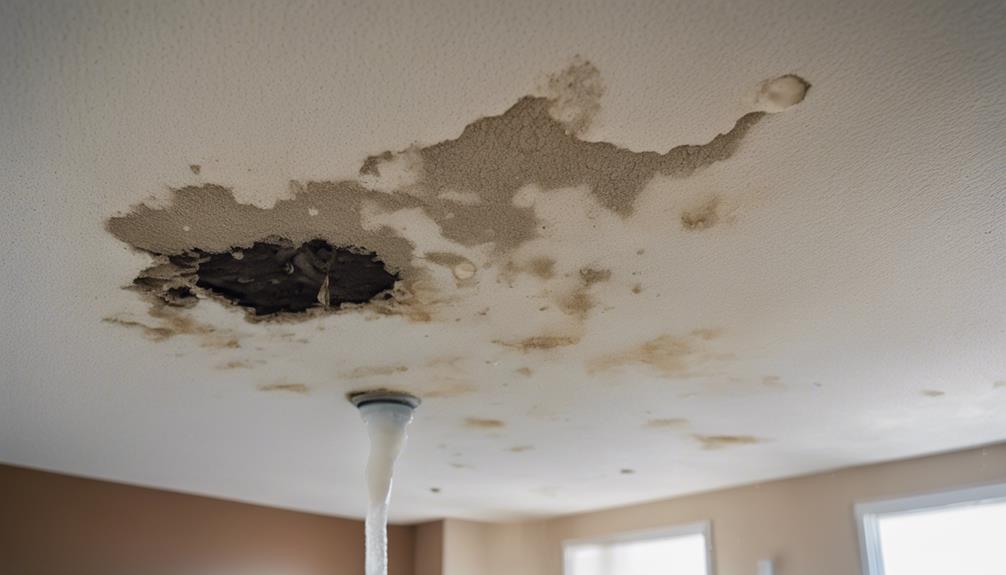
Water damage in condominiums can create confusion about who's responsible for repairs. Typically, the condominium declaration, known as the CC&Rs, outlines these responsibilities. As a unit owner, you're usually responsible for water damage originating from your unit, like a burst pipe or an appliance leak.
However, if the damage affects common areas, the homeowners association (HOA) will handle those repairs. It's important to note that approximately 25% of home insurance claims involve water damage, highlighting the need for adequate coverage insurance coverage for water damage.
It's crucial to understand how your condo insurance policy works in these situations. Your HO-6 policy should cover personal property and improvements within your unit, while the HOA's master policy generally covers common elements.
Be aware that negligence, such as failing to maintain your plumbing, could shift repair costs to you, even if the damage impacts common areas.
Review both your personal and the HOA's insurance policies carefully to identify any exclusions. Neglect or routine maintenance issues often aren't covered, which means you could be responsible for significant repair costs.
Knowing your responsibilities and having the right insurance can save you from unexpected expenses and confusion during stressful times. Stay proactive to protect yourself and your investment.
When dealing with water damage in a condominium, understanding negligence and liability is essential for unit owners. When a leak occurs, you need to assess where it originated. If it's from your unit, you're likely responsible for repairs. However, if it comes from a common area maintained by the homeowners association (HOA), they may bear the liability.
To clarify your responsibilities, refer to the governing documents, including the Covenants, Conditions, and Restrictions (CC&Rs). Insurance adjusters often require proof of negligence to approve water damage claims. If routine maintenance wasn't performed, this could affect liability.
Here's a quick guide to help you assess negligence and liability:
| Aspect | Responsibility |
|---|---|
| Unit Owner Repairs | Responsible for damage |
| Common Area Issues | HOA likely responsible |
| Documentation | Essential for claims |
| Insurance Claim Approval | Requires proof of negligence |
| Legal Advice | Needed for complex cases |
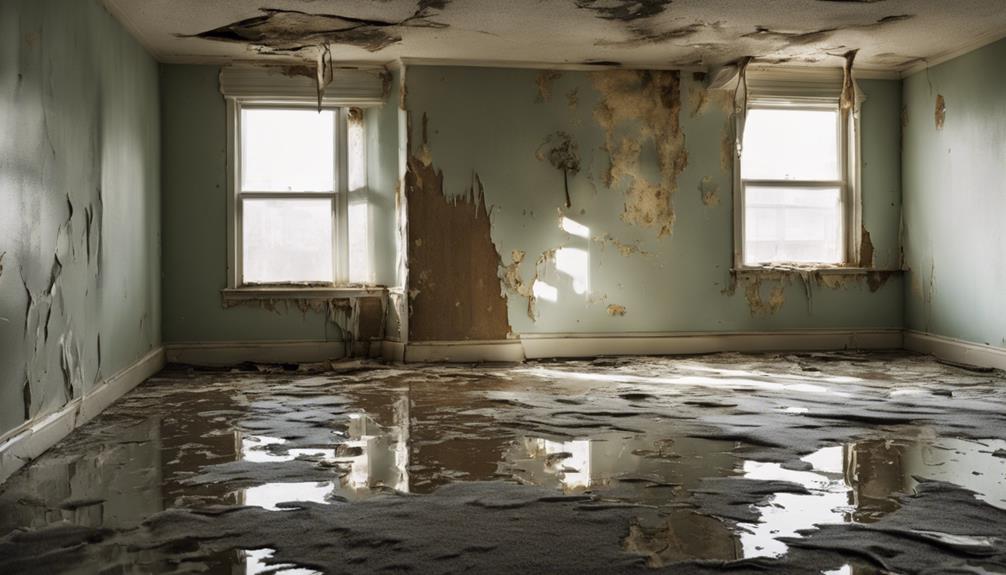
Understanding your responsibilities regarding negligence and liability lays the groundwork for navigating insurance coverage in a condominium. The type of condo master insurance policy—bare walls, single entity, or all-in—determines your coverage extent for unit and shared structure damages. This can significantly impact your financial responsibility when water damage occurs.
Your homeowners insurance, typically an HO-6 policy, usually covers sudden or accidental water events, but it often excludes maintenance-related issues. It's crucial to review your individual insurance policies to identify any gaps in coverage. For instance, standard homeowners insurance doesn't usually cover flood damage, so you may need a separate flood insurance policy to protect against those risks.
Each unit owner contributes to the HOA Master insurance policy through assessments, ensuring common areas are covered. However, understanding the exclusions within your condo insurance—like neglect or wear and tear—is vital, as these can leave you vulnerable during water intrusion incidents.
Repair costs for water damage in condominiums can quickly add up, especially if they fall under the deductible limits of your HOA's insurance policy. If the costs are below the deductible, like in a scenario where your HOA's deductible is $10,000 and the repair expenses amount to $5,000, you'll need to cover that entire amount without any insurance assistance.
Homeowners must carefully review their association's declarations to understand whether they're responsible for losses that fall within these deductible limits. Colorado law, C.R.S. 38-33.3-313(6), allows associations to set policies regarding deductible responsibilities, which can significantly impact your financial obligations.
Additionally, be aware that certain exclusions in the HOA's insurance policy can further complicate repair costs. Common exclusions, such as mold or groundwater intrusion, leave you liable for those damages.
However, if the water damage is covered and exceeds the deductible, the association is responsible for filing an insurance claim to recover those repair costs, which will then likely be shared among unit owners through assessments.
Always stay informed to avoid unexpected financial burdens!

Preventing water damage in your condo starts with proactive maintenance. Regularly inspect appliances like washing machines and dishwashers. Check hoses for cracks and replace them every 2-5 years to prevent leaks.
Schedule annual checks of your water heater, especially since these usually fail after 12 years. Look for rust, leaks, and deterioration to ensure proper functioning.
Don't forget about your gutters and downspouts! Clean them regularly to prevent clogs that can lead to water pooling around your foundation, which could cause significant water damage.
Inside your condo, inspect plumbing under sinks and cabinets for any signs of leaks or rust. Address these plumbing issues promptly to mitigate potential damage.
Also, ensure the watertight seals of caulk around tubs, sinks, and toilets are intact. This helps prevent water seepage and subsequent damage to surrounding areas.
By taking these maintenance steps, you not only protect your home but also minimize the risk of needing to file an insurance claim for water damage.
Consider discussing these tips with your homeowner association to promote a community-wide approach to water damage prevention.
When you face water damage in your condo, starting the claims process can feel overwhelming.
You'll want to document the damage thoroughly with photos or videos before making any repairs.
Additionally, keeping a detailed record of your communications with the insurance company is crucial to ensure a smooth claims experience.
Documenting damage evidence is crucial for a successful claims process following water damage in your condo. Start by taking clear, detailed photographs or videos of all damage before making any repairs. This visual evidence is essential for your insurance claim.
Here's a quick guide to help you document effectively:
| Action | Details | Importance |
|---|---|---|
| Photograph Damage | Capture all affected areas and items | Provides visual evidence for claims |
| Maintain a Written Log | Record dates, representatives, and discussions | Keeps track of communications with insurers |
| Keep Damaged Items | Retain items until evaluated by the adjuster | Ensures all evidence is available |
| Review Your Insurance Policy | Understand coverage and exclusions | Helps you prepare necessary documentation |
When filing your claim, include the specific date and cause of the loss along with your insurance policy number. Proper documentation not only expedites the claims process but also strengthens your case for coverage regarding property damage. By following these steps, you can navigate the claims process with confidence.
Effective communication with your insurer is essential to navigate the claims process for water damage smoothly. When you file an insurance claim, it's crucial to provide documented evidence of the damage, including photos or videos.
Make sure you log all communications with the insurance company, noting dates, representatives' names, and discussion points. This will help clarify your case.
During your first notice of loss, be ready to share specific details like the date of the incident, the cause of loss, and your policy number. An insurance company is required to begin their investigation within 15 days after you submit your claim, and you should receive a claim number soon after.
If the water damage affects common areas or personal property, understanding your association's responsibilities is key. Coverage for water damage can vary, so knowing your owners responsibility is important.
Once an adjuster is assigned, it's beneficial to be present during their inspection. This way, you can clarify damage details and ensure all relevant information is included in the claims assessment. Clear communication will streamline the process and help you secure the compensation you deserve.
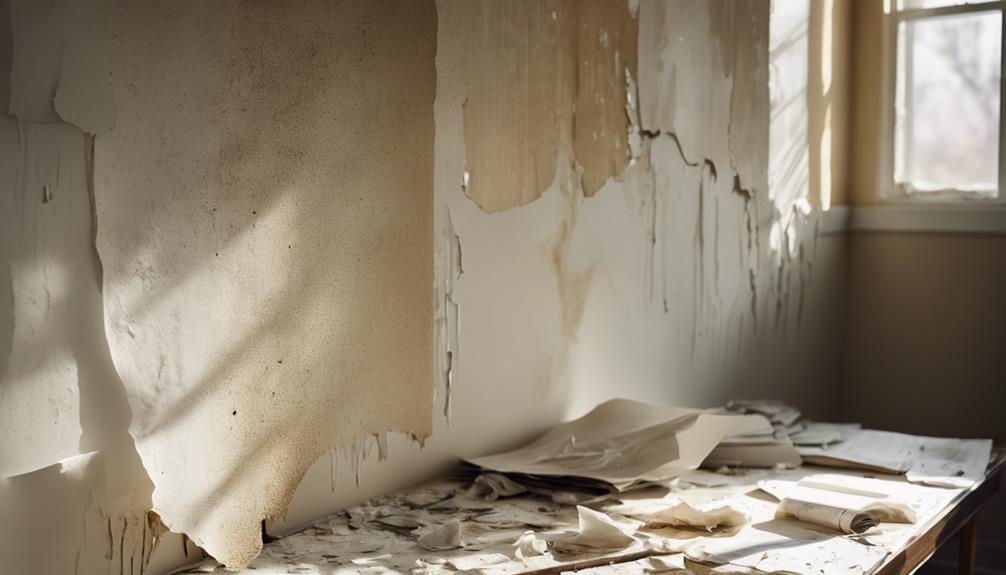
When it comes to condo water damage, understanding liability assignments is crucial for you as a homeowner.
Keeping thorough documentation of all related communications and incidents can significantly strengthen your position if disputes arise.
Additionally, knowing your insurance coverage and ensuring it complements your HOA's master policy can protect you from unexpected costs.
Navigating liability assignments in condominium water damage cases can be complex, but understanding the governing documents is key. These documents, like the CC&Rs, detail the responsibilities of both homeowners and the HOA. You need to differentiate between common elements and individual units, as this distinction determines who's liable for repairs. Generally, the HOA is responsible for common areas, while individual unit owners must handle damage within their spaces.
Here's a quick reference to help clarify liability assignments:
| Type of Damage | Responsible Party | Key Consideration |
|---|---|---|
| Common Elements | Homeowners Association (HOA) | HOA's obligations under governing docs |
| Individual Units | Unit Owners | Owner's liability unless specified otherwise |
| Negligence-Related | Depends on circumstances | Owner may be liable if their negligence contributes to damage |
| Claims on Liability | Varies by case | Legal advice can clarify specifics |
Negligence can significantly impact liability assignments, so consulting legal professionals can help clarify your responsibilities and rights. Understanding these elements is essential for effectively navigating claims related to water damage.
Documenting water damage thoroughly is vital for homeowners and associations alike, as it supports insurance claims and establishes the damage's extent. You should take detailed photographs and videos of the affected areas immediately. This documentation will be crucial for any discussions with your HOA or insurance adjuster.
Keeping a log of all communication with both the insurance adjuster and the HOA helps create a clear record of interactions and decisions. This log can clarify who's responsible for what and inform your understanding of your coverage. Historical documentation of previous repairs and maintenance can also assist in assessing current responsibilities.
It's essential to obtain written documentation from the insurance adjuster regarding their coverage decisions. This evidence can be invaluable if disputes arise later in the claims process.
Moreover, regular updates from your HOA about insurance coverage and individual responsibilities enhance transparency. This way, all homeowners stay informed about their obligations related to water damage claims, reducing confusion and potential disputes.
How does your Homeowners Association (HOA) handle water damage? Understanding the HOA responsibilities is crucial, especially when it comes to maintaining common areas like roofs and plumbing systems.
If water damage originates from these shared structures, the HOA's master insurance policy may cover the repair costs. However, it's essential to know the specifics of this policy, as coverage can vary widely—some may only cover the bare walls, while others might include everything.
For issues arising within your unit, you'll likely need to file a claim with your personal insurance. The condominium association typically handles claims related to common area damages, but clear communication with your HOA is vital.
Timely reporting of water-related incidents can expedite maintenance actions, potentially limiting further damage and costs.
Always stay informed about your HOA's policies and procedures to ensure you're prepared should water damage occur. This proactive approach can save you from unexpected expenses and provide peace of mind during stressful situations.
In California, if you're dealing with a water leak in your condo, you need to know your maintenance responsibilities.
Typically, you're responsible for issues within your unit, including plumbing issues. However, if the leak comes from common areas, your homeowner association may be liable.
Review your condo insurance and the association's governing documents to understand tenant rights and to file any damage claims for repair costs effectively.
A slab leak typically falls under the HOA's maintenance obligations, especially if it involves the plumbing system serving multiple units.
You should check your association's governing documents to clarify responsibilities.
Common area insurance often covers these leaks, but it's vital to implement leak prevention strategies.
Also, be aware of tenant liability issues, as individual unit owners might still face costs.
Always follow emergency response protocols for prompt reporting to minimize further damage.
When it comes to leaks from upstairs neighbors, insurance coverage varies based on your policy.
You'll want to check your policy coverage for leak detection and maintenance responsibilities. If you face neighbor disputes, document everything for potential insurance claims.
Emergency repairs might be necessary, but liability issues can complicate things. Understanding your tenant rights is crucial, as your coverage may not extend to maintenance-related leaks.
Always communicate with your insurance provider for clarity.
When you're dealing with a water leak, understanding the causes is crucial.
Typically, condo maintenance responsibilities fall on you as the unit owner, especially if it's due to your plumbing. Familiarize yourself with tenant rights, HOA rules, and relevant insurance policies.
If the leak breaches building codes or plumbing regulations, that could shift repair costs.
Always document the situation to clarify responsibilities and ensure timely repairs and coverage.
In dealing with condo water damage, understanding your responsibilities is key. Whether it's your negligence or the HOA's, knowing who pays can save you stress and money. Always check your insurance coverage and stay proactive with maintenance to prevent future issues. If disaster strikes, follow the claims process carefully and seek legal advice if needed. By staying informed, you can navigate the complexities of water damage and ensure you're covered when it matters most.
When it comes to water damage in your apartment, responsibility typically falls on both you and your landlord. Landlords must maintain habitable conditions and address repairs promptly, especially if the damage isn't your fault. If you notice water damage, notify your landlord right away to minimize further issues. You have rights, too; for serious damage that affects safety, you might be able to withhold rent or use the "repair and deduct" method. Keeping detailed documentation of communications is crucial. Understanding the nuances of these responsibilities can help protect your rights effectively. You might find more helpful insights on this topic.
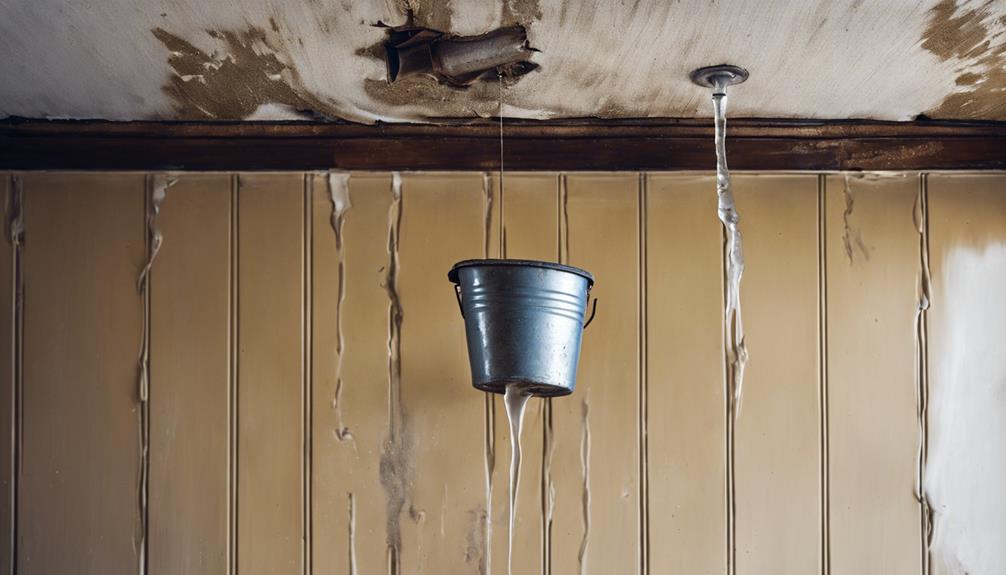
When it comes to water damage in rental properties, landlords can't just brush it off; they've specific legal responsibilities to uphold. Under California law, landlords must maintain habitable living conditions, which includes addressing water damage issues promptly.
If you notice leaks or other water-related problems that aren't caused by your actions, it's the landlord's responsibility to handle the necessary repairs.
California Civil Code Sections 1941 and 1942 require landlords to fix these problems ideally within 30 days for non-urgent issues. Ignoring water damage can lead to serious consequences, such as structural damage and health risks like mold growth.
Landlords must act swiftly to mitigate these hazards to ensure tenant safety and compliance with lease agreements.
Failure to address water damage can lead to legal disputes over tenant rights and obligations. If you find that your landlord isn't taking action, document the issue and communicate your concerns clearly.
As a tenant, you have important rights and protections when it comes to water damage in your home.
It's crucial to report any issues promptly and understand your options for rent withholding if repairs aren't made.
Familiarizing yourself with your insurance coverage for water damage can further empower you to take action and ensure your living environment remains safe and habitable.
Knowing your rights can empower you to take action and ensure your living environment remains safe and habitable.
Understanding your rights as a tenant is essential, especially regarding water damage and the necessary repairs. In California, tenant protections ensure you have a habitable living environment, which includes timely repairs for issues like water damage not caused by your negligence.
If your landlord neglects significant issues, such as mold remediation, you can utilize the "repair and deduct" method. This allows you to fix the problem and subtract the cost from your rent.
When serious water damage renders your apartment uninhabitable, you have the right to withhold rent as long as you provide proper notice and documentation.
Remember, effective communication with landlords about water damage is crucial. It helps you establish a record of negligence, protecting your rights and responsibilities in potential disputes.
California law also allows you to abandon your rental unit if the necessary repairs exceed one month's rent, ensuring you're not forced to live in unsafe conditions.
Promptly reporting water damage issues is vital for protecting your rights as a tenant. When you notice any signs of water damage, it's your legal responsibility to notify your landlord immediately. This not only helps prevent further damage but also shields you from potential liability.
Under California law, landlords must maintain a habitable living environment, and failing to address serious water damage can lead to significant health and safety concerns.
Documenting water damage issues is crucial. Keep a record of your repair requests, including written communication and photographs of the damage. This documentation can serve as evidence if the situation escalates or if you need to demonstrate landlord negligence.
If your landlord doesn't act, California law gives you options. You might've the right to withhold rent or use the "repair and deduct" method for necessary repairs.
The right to withhold rent can empower tenants facing serious water damage that compromises their living conditions. In California, if your landlord neglects substantial issues affecting health or safety, you can legally withhold rent under California Civil Code Sections 1941 and 1942.
However, remember that this right is reserved for significant problems, like mold growth or structural concerns, not minor repairs.
Before you withhold rent, it's essential to provide written notice to your landlord about the water damage. Allow them a reasonable timeframe to address the issue.
If they fail to make repairs in that time, you might consider the "repair and deduct" option, where you can deduct repair costs from your rent. Just make sure to keep thorough documentation of all communications and repair requests with your landlord; this will be vital if disputes arise.
Always bear in mind that any tenant negligence on your part could undermine your position.
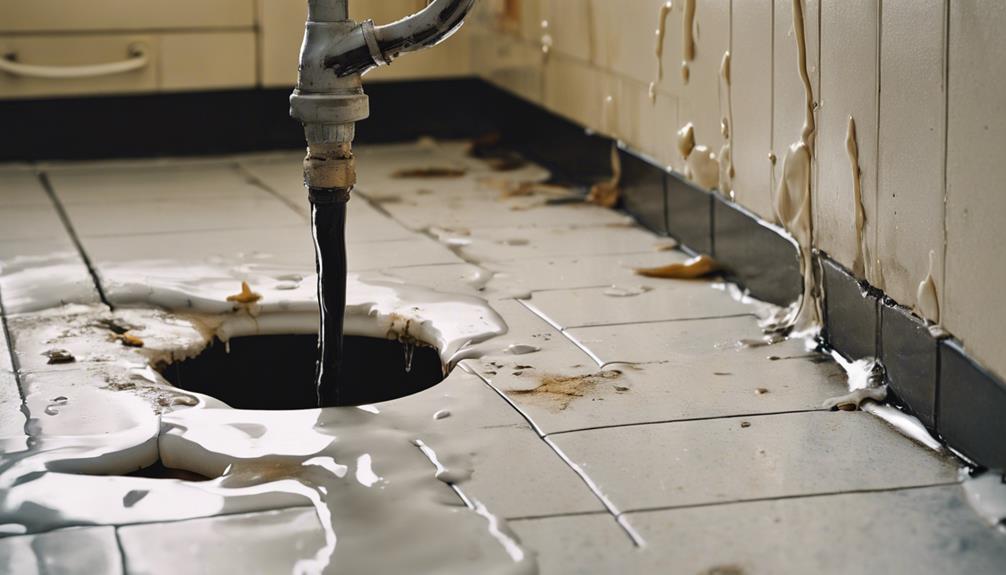
Water damage can wreak havoc on your living space, often stemming from several common causes. One major culprit is plumbing leaks, particularly from burst pipes, which can lead to substantial structural damage and costly repairs averaging around $3,362 per incident.
Roof leaks, often due to poor maintenance, can allow water to seep into walls and ceilings, increasing the risk of mold growth and potential health issues.
Appliance malfunctions, such as faulty dishwashers or washing machines, can also result in significant water accumulation, damaging your flooring and surrounding areas.
Additionally, flooding from external sources—like heavy rains or sewer backups—poses a risk to all ground-level units and may necessitate specialized remediation efforts.
Lastly, tenant negligence can exacerbate water damage. Leaving windows open during storms or failing to report leaks promptly can worsen the situation, complicating liability issues.
When you notice water damage, reporting it to your landlord quickly is essential to protect yourself from further liability.
Documenting the damage with photos and written communication creates a clear record that can be invaluable in disputes.
Make sure to detail the issue and keep a log of all your communications to ensure timely repairs and safeguard your rights.
Promptly reporting water damage is essential for minimizing further issues and protecting your rights as a tenant. When you notice water damage in your property, immediately contact your landlord to report the issue. This quick communication not only helps limit further damage but also establishes a record of the problem, which is crucial for any insurance claims or potential repairs.
Under California law, landlords must address urgent water damage repairs right away and non-urgent repairs within 30 days. So, it's vital to document everything. Take photos and write detailed descriptions of the damage, then submit this documentation to your landlord.
Keeping a log of all your communications regarding the water damage will create a timeline that shows you're proactive about resolving the issue.
If your landlord fails to act promptly, you may consider using the "repair and deduct" option, allowing you to handle urgent repairs yourself and deduct the costs from your rent. This option emphasizes the importance of timely reporting and highlights your rights as a tenant under the lease agreement.
Effective documentation is your best ally in managing water damage issues. When you promptly report water damage, it's essential to create a comprehensive record that can support your claims and repair requests.
Here's what you should do:
Timely documentation is crucial. Delays can complicate liability and lead to further damage or health risks, making your claims harder to support.
By effectively managing your documentation, you're not just protecting your rights; you're also ensuring that necessary repairs happen swiftly and efficiently.
Don't underestimate the power of well-organized documentation—it's your strongest tool in navigating the complexities of water damage situations.
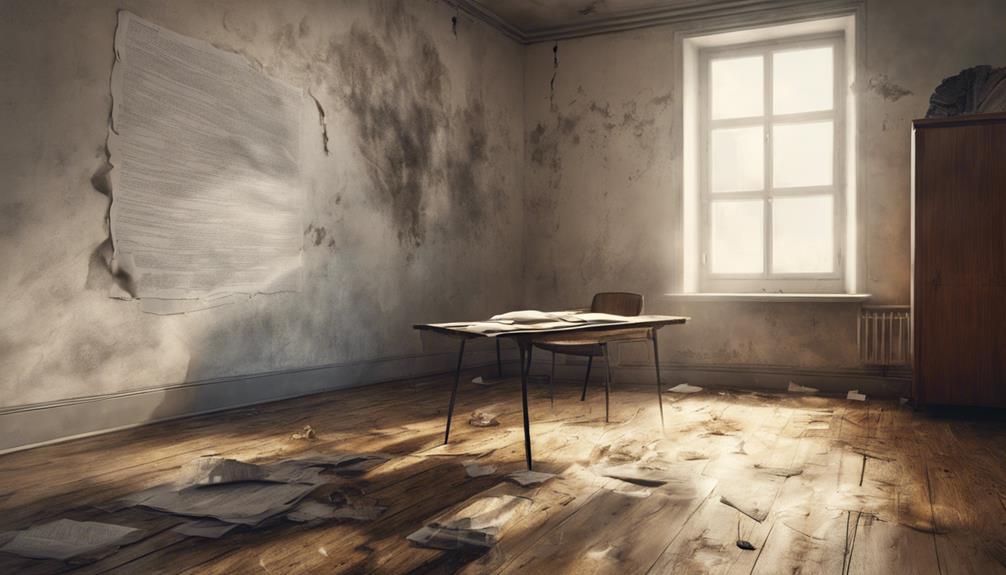
In navigating disputes over water damage, clear communication often proves essential. Effective dispute resolution strategies can help you address issues with your landlord while ensuring your rights are protected. Start by documenting all communications and water damage incidents to create a clear timeline and establish responsibility for repairs.
Engaging in open dialogue with your landlord can facilitate quicker resolutions. If urgent repairs are necessary, consider utilizing the "repair and deduct" option, which allows you to address issues yourself and deduct the costs from your rent if your landlord fails to act promptly.
If discussions stall, mediation services can provide a neutral platform for both parties to discuss grievances and find mutually agreeable solutions without resorting to litigation. Familiarize yourself with tenant-landlord laws to reinforce your position and ensure you're aware of your rights and your landlord's obligations.
| Strategy | Description |
|---|---|
| Documenting | Keep records of all communications and incidents. |
| Open Dialogue | Communicate openly to resolve issues quickly. |
| Repair and Deduct | Address urgent repairs and deduct costs from rent. |
| Mediation Services | Use neutral services to find amicable solutions. |
Understanding your insurance coverage is crucial when it comes to water damage. Knowing what your policies cover can save you from financial headaches later on. Here are three key points to remember about insurance in a rental property:
When dealing with insurance claims, it's vital to review your renters insurance policy to ensure it covers various water-related incidents, including mold damage.
Understanding the differences between landlord insurance and your own policy can help you navigate these situations effectively, ensuring you're adequately protected against potential losses.
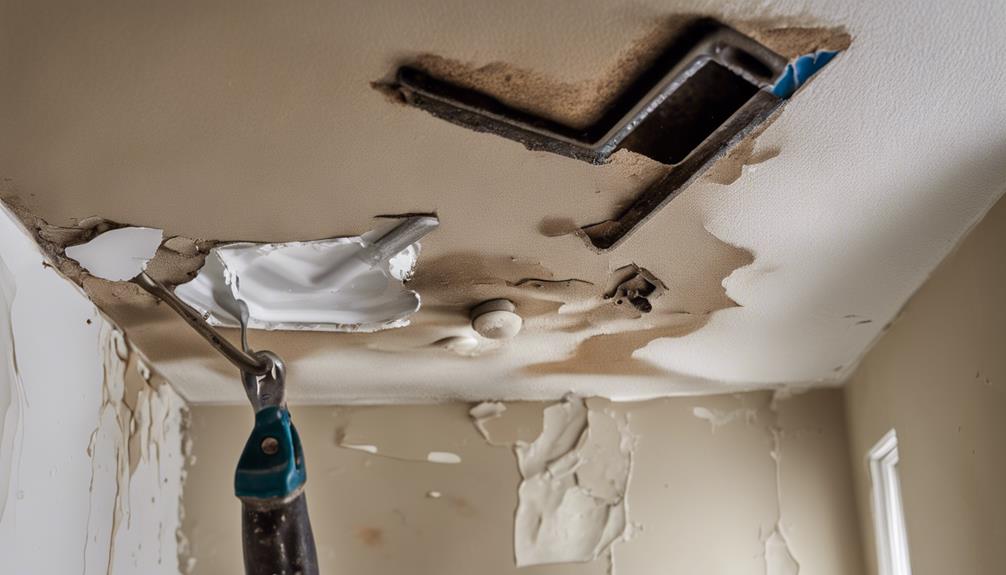
When water damage occurs, knowing who's responsible for repairs is key to resolving the issue efficiently. Landlords are responsible for repairing water damage that isn't caused by tenant negligence, ensuring your apartment remains habitable under California Civil Code.
The repair processes typically start with identifying and fixing the source of water damage, followed by mitigating further property damage.
As a tenant, it's crucial you report water damage promptly. Delaying notification can lead to liability for additional damages. Keep detailed documentation of all incidents, repair requests, and communications with your landlord. This record will help clarify responsibilities and streamline the repair process.
In cases of severe water damage, specialized contractors may be necessary. In such situations, landlords are responsible for coordinating these services to restore the property effectively.
In California, your landlord has specific obligations regarding water damage repairs. For emergency repairs, they must act immediately.
For non-urgent issues, they've got a 30-day timeline. Understanding your tenant rights is crucial.
If repairs aren't done on time, you can explore legal remedies, like "repair and deduct" or withholding rent.
Always document issues and refer to your lease agreements for clarity on maintenance responsibilities and insurance coverage related to water damage claims.
In Florida, your landlord's got specific repair timelines for water damage.
For emergency repairs affecting health and safety, they've gotta act within 7 days.
For non-urgent maintenance, you're looking at 15 days.
If they don't meet these obligations, know your tenant rights!
You can withhold rent or seek legal remedies.
Always document issues and follow your lease agreements.
Property inspections may also help support any insurance claims you might file.
When you encounter a water leak, understanding tenant rights and landlord obligations is crucial.
Typically, landlords must address leaks from structural issues, while you're responsible if negligence caused the problem.
Document everything for insurance claims and ensure you report leaks promptly to avoid legal liabilities.
Check your lease agreements for maintenance responsibilities and repair timelines.
In emergencies, follow procedures to mitigate property damage and safeguard your living space.
In Colorado, you might be responsible for water damage if negligence led to the issue.
Under Colorado laws, tenant liability arises when you ignore water leaks or fail to maintain appliances. Your lease agreement outlines maintenance obligations, while landlords must address repairs promptly.
Understanding your tenant rights is crucial; you can pursue repair timelines if they don't comply.
Also, check your insurance coverage, as it may help with water damage claims.
In the end, understanding who's responsible for water damage in your apartment can save you time and stress. Remember, landlords are typically accountable for major repairs, but tenants should report issues promptly. Always know your rights and protections, and keep communication open with your landlord. If disputes arise, don't hesitate to seek resolution strategies. Finally, check your insurance coverage, as it might help with unexpected costs. Being informed puts you in a better position to handle these situations.
To file a home insurance claim for water damage, start by stopping the leak and documenting the damage with photos. Check your policy to understand your coverage, especially regarding sudden incidents versus maintenance issues. Report the claim to your insurance company as soon as possible. Fill out the necessary forms and keep a detailed log of all communications throughout the process. If needed, hire professionals for cleanup, and save any receipts for reimbursement. Communicate effectively with your adjuster and don't hesitate to challenge settlement offers that seem low. There's much more to navigate successfully, so stay informed.
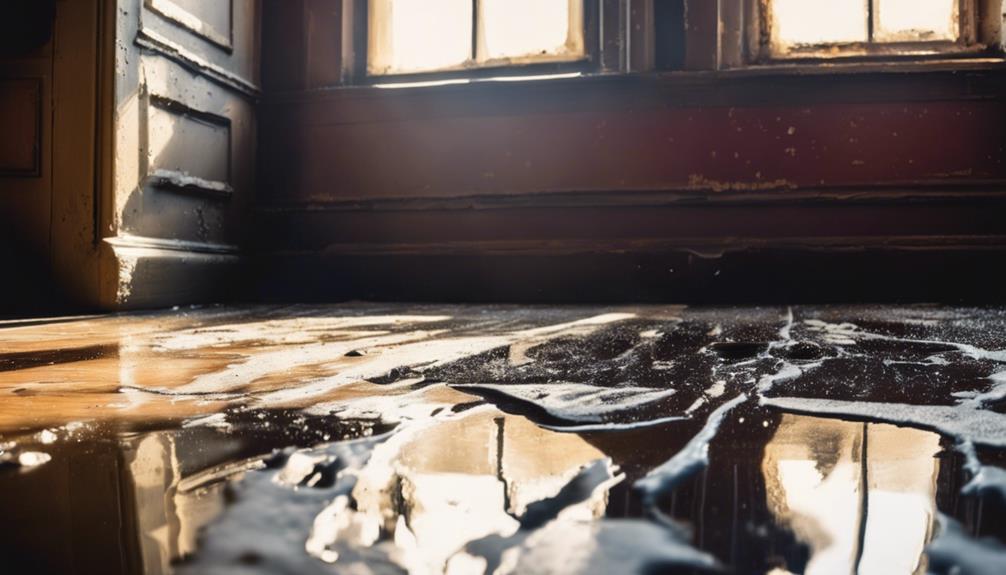
Assessing water damage requires a keen awareness of both the immediate situation and its potential consequences. First, you need to identify the source of the water. Stopping the leak is crucial, as prolonged exposure can lead to further deterioration and mold growth within 24-48 hours.
Regular inspections of plumbing systems can help prevent such leaks before they occur. Once you've addressed the source, it's time to document the damage thoroughly. Use photographs and videos to capture affected areas and items; this visual evidence is vital for insurance claims and potential reimbursement.
Next, evaluate the extent of the damage by checking for structural integrity and signs of mold. If you notice anything concerning, consider hiring a professional for inspection to ensure safety and compliance with building codes.
Throughout this process, maintain a comprehensive log of all communications and actions taken, including dates, times, and details of conversations with contractors or insurance agents.
Navigating the complexities of your homeowners insurance policy is essential for effectively handling water damage claims. You need to understand what your insurance coverage includes and excludes. Typically, homeowners insurance covers water damage from sudden incidents like burst pipes or storm-related leaks. However, it usually doesn't cover gradual damage due to maintenance neglect.
It's crucial to note that standard policies often exclude flood damage, requiring you to purchase separate flood insurance if you live in a flood-prone area. In fact, in 2018, about 25% of home insurance claims were related to water damage, emphasizing the importance of knowing your coverage.
Additionally, familiarize yourself with the distinction between Actual Cash Value (ACV) and replacement cost. ACV factors in depreciation, while replacement cost provides the full amount needed to replace damaged items.
To ensure you're fully aware of your homeowners insurance specifics and potential limitations, consider reviewing your policy with an independent agent. They can clarify your coverage, helping you prepare for any future water damage claims.
Understanding your policy now can save you time and stress later.

Once you report your claim, it's crucial to understand the timeline and what documentation you'll need.
You'll also want to communicate effectively with adjusters to ensure a smooth claims process.
Let's break down the essential steps for reporting your claim accurately and efficiently.
Reporting your water damage claim promptly is crucial to kickstart the recovery process. As soon as you notice the damage, reach out to your insurance company. Most providers offer 24/7 claim reporting, making it easier to initiate the claim process quickly.
Remember, timely reporting is essential; delays could lead to complications or even denial of coverage.
Once you've reported the damage, be prepared for the next steps. Insurance companies typically have specific timelines for processing claims, which can take anywhere from a few days to several weeks, depending on the complexity of the situation.
To ensure everything goes smoothly, document all communications with your insurance provider. Keeping a clear record will help you track the progress and address any disputes or delays that might arise.
After your initial report, you may need to fill out a proof of loss form and provide detailed evidence of the damage. This additional information can expedite the claims process and help your insurance company assess your situation more accurately.
Stay proactive throughout this period, and you'll be better positioned to receive the assistance you need.
Gathering the right documentation is essential for a smooth claims process after water damage. Start by taking clear photographs of all affected areas and items, capturing both the damage itself and the source of the water intrusion. This visual evidence will be crucial to support your claim.
Next, document the details of the incident, noting the date, time, and circumstances surrounding the damage, as well as any immediate actions you took to mitigate further issues.
Collect receipts and invoices for any temporary repairs or emergency services you utilized; these costs might be reimbursable under your insurance policy.
Additionally, maintain a detailed log of all communications with your insurance provider. Note the dates, times, and names of representatives you spoke with to establish a clear record of your claim process.
After you've gathered all the necessary documentation, it's time to communicate with your insurance adjuster. Start by having your insurance policy number ready; this will help expedite the claims process.
When reporting your claim, be prepared to provide detailed descriptions of the damage, including the source of the water and the extent of the impact on your property. Your adjuster will need to evaluate the damage, so thorough documentation is crucial.
Take photos, jot down notes, and make a list of affected areas to share during your conversation. Remember, the more evidence you provide, the better they'll understand your situation.
It's also essential to document all communications with your adjuster. Note the dates, times, and key discussion points to maintain clarity throughout the claims process.
Don't hesitate to follow up proactively after your initial report; timely communication can facilitate a smoother experience.
If you have questions or concerns, reach out to your insurance agent for guidance. They can help clarify any uncertainties and ensure you're on track to receive the compensation you deserve.
When faced with water damage, enlisting the help of a professional cleanup and restoration company is crucial. These licensed and insured experts use specialized equipment and techniques to effectively remove water and prevent mold growth. Their quick response can significantly reduce the risk of mold development, which can start within just 24-48 hours of exposure.
A thorough assessment of the damage is part of professional cleanup. Restoration professionals will detect moisture levels and develop a tailored remediation plan addressing all affected areas. They should provide you with written estimates and timelines, so you understand the scope of work and associated costs.
Additionally, make sure to keep all documentation from the restoration company. Reports and photos of the cleanup are vital for supporting your insurance claims, ensuring you receive accurate reimbursement.
Having this evidence can streamline the claims process and help you recover your losses more efficiently. Ultimately, hiring a water damage restoration company not only ensures your home is properly restored but also strengthens your insurance claim, making it easier for you to get back on track.
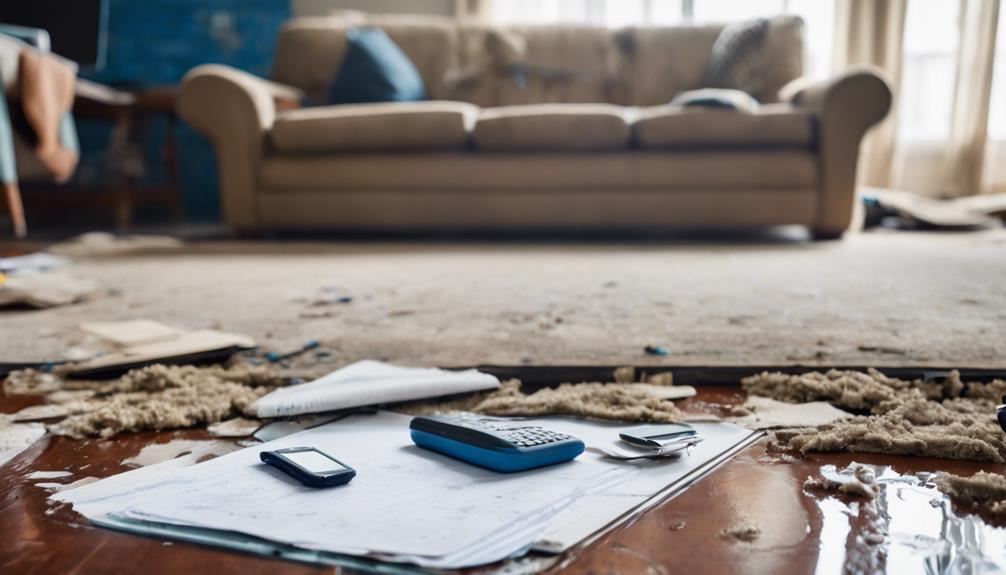
Interacting with adjusters can significantly impact your home insurance claim for water damage. To make the most of this process, prepare a detailed inventory of damaged items, complete with photos, dates, and descriptions. This will help you communicate effectively and support your claim.
Keep a clear log of all communications with the adjuster, noting dates, times, and key discussion points. This ensures transparency and accountability throughout the process.
When the adjuster arrives, they'll conduct a thorough inspection of the affected areas. Make sure all damage is accessible and well-documented to aid in their damage assessment.
Be ready to provide any additional information they may request, as this can facilitate their evaluation and speed up your claim process.
If you find yourself disagreeing with the adjuster's assessment, remember that you have the right to seek a second opinion from a public adjuster. They can advocate on your behalf to ensure you receive a fair settlement.
Navigating the settlement process for your water damage claim involves several key steps that can significantly impact your outcome.
First, you should contact your insurance agent to report the water damage and initiate the claims process; having your policy number handy will expedite this step. An insurance adjuster will then evaluate the property damage and determine the settlement amount, which will likely depend on your coverage type—either Actual Cash Value or Replacement Cost.
To ensure a smooth process, maintain detailed records of all communications with your insurance company, including dates, times, and key discussion points. If you disagree with the initial settlement offer, don't hesitate to challenge it. You can provide independent estimates from licensed contractors to negotiate for a higher payout.
Throughout the settlement process, be aware that you might receive multiple checks—one for property repairs and another for personal belongings.
Also, checks for home repairs may require endorsement from your mortgage lender, so stay informed. By following these steps, you'll navigate the settlement process more effectively and increase your chances of a favorable outcome.
Insurance for water damage coverage varies based on your policy. It typically covers sudden and accidental types of water damage, like burst pipes or leaks.
However, it excludes gradual damage from neglect and flood damage, which needs separate policies. You need to know the specifics of your insurance policy exclusions to avoid surprises.
Understanding the difference between Actual Cash Value and replacement cost can also impact how much you get back for your claims.
A water damage claim can be denied for several common reasons.
If the damage results from neglect or lack of maintenance, insurers often cite policy exclusions.
Gradual leaks not reported promptly might also lead to rejection, as timely documentation requirements are crucial.
Additionally, if you lack separate flood insurance for flood-related damage, your claim could be denied.
Always review your policy to understand what's covered and avoid surprises during the claims process.
To make a successful water leak insurance claim, start by taking preventive measures to avoid future issues.
Document everything with clear photos and detailed descriptions.
When you report the damage, provide your insurance agent with your policy number and a thorough account of what happened.
Be ready for the insurance adjuster's visit, and don't forget to keep all receipts and records of temporary repairs to support your claim documentation effectively.
Filing a homeowners insurance claim can come with several disadvantages.
You might face premium increases after the claim, as insurers often reassess your risk based on your claim history.
Additionally, your coverage limits could be tested, especially if the damage resulted from maintenance neglect, leading to denied claims.
It's also possible to experience delays in receiving payouts, making the process frustrating when you need help the most.
Consider these factors carefully before filing.
Filing a home insurance claim for water damage can feel overwhelming, but you've got the tools to handle it. By assessing the damage, understanding your policy, and working closely with adjusters, you can navigate the process more smoothly. Don't forget to document everything and seek professional help when needed. With the right approach, you'll be on your way to getting the settlement you deserve and restoring your home back to its former glory.
A landlord has specific timeframes to fix water damage. For urgent issues, such as severe leaks, they'll need to act within 24 to 72 hours. Non-urgent repairs, like minor mold, usually must be resolved within 30 days. It's crucial to notify your landlord in writing to establish a timeline and protect your rights. If they don't respond in a timely manner, this may lead to health risks, increased repair costs, and potential legal action. Understanding these timelines will help you navigate the situation more effectively, and there's more to know about your rights and options.
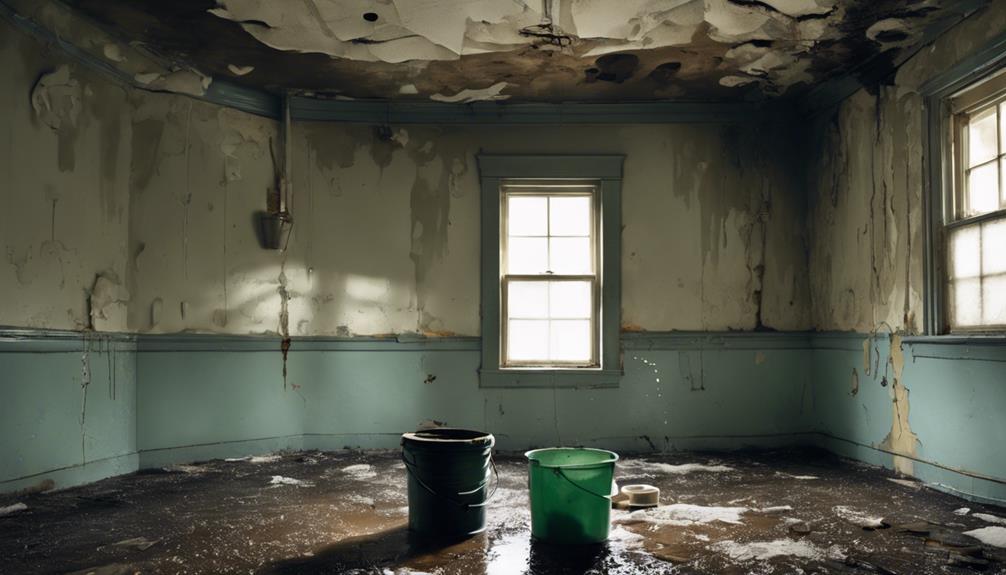
When it comes to water damage, how quickly should landlords act? Your responsibilities as a landlord are clear under California law.
If water damage poses a health or safety risk, you must tackle those urgent repairs within 24 to 72 hours. It's crucial to maintain habitable living conditions, especially since failure to address significant water damage promptly could lead to legal repercussions, including claims for breach of the warranty of habitability.
Additionally, understanding your insurance coverage for water damage can help you navigate potential financial liabilities associated with repairs.
For non-urgent repairs, you typically have up to 30 days to complete the necessary work. However, it's essential to act within a reasonable time frame to prevent issues like mold growth, which can further complicate repair costs and tenant health.
You're not just fixing the property; you're ensuring a safe and livable environment for your tenants.
Understanding the distinction between urgent and non-urgent repairs is essential for both landlords and tenants. Urgent repairs, particularly those involving significant water damage that impacts habitability, must be addressed by landlords within 24 to 72 hours according to California law. This is crucial for maintaining health or safety in the living environment.
If you notice such urgent issues, you must notify your landlord promptly in writing to initiate the repair timeline effectively.
On the other hand, non-urgent repairs related to water damage, like cosmetic concerns or minor leaks, should typically be resolved within 30 days. While these issues may not pose immediate risks, timely repairs still matter to ensure your living conditions remain comfortable.
If landlords fail to address urgent water damage within the specified timeframe, you have legal remedies available, such as withholding rent or filing a complaint.
To strengthen your position, it's important to document communications regarding all repair requests. Keeping a clear record will support your claims if landlords neglect their obligations and help ensure that you receive the necessary repairs in a timely manner.
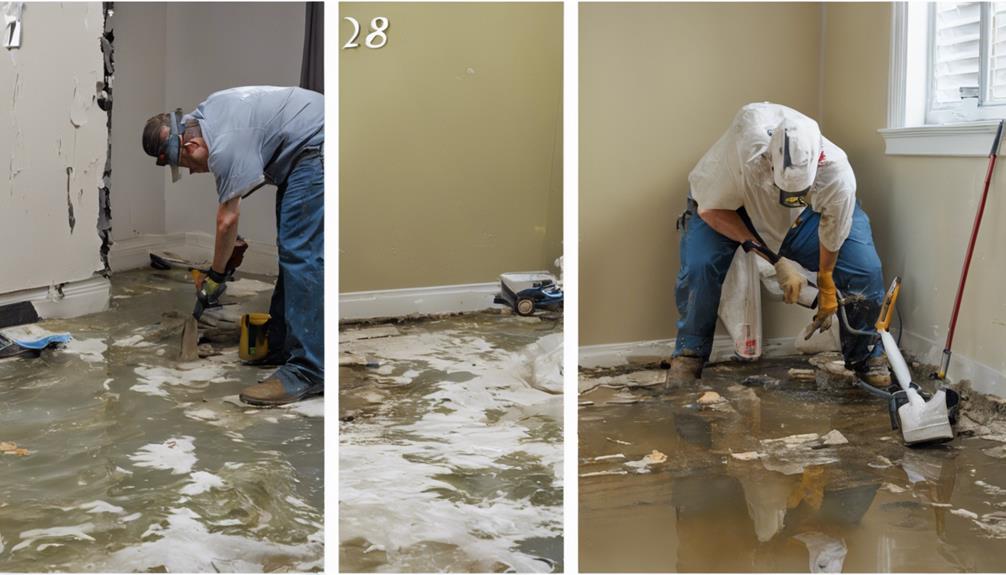
Knowing the repair timeframes by state can really help you understand your rights as a tenant.
Each state has specific guidelines that distinguish between urgent and non-urgent repairs, affecting how quickly your landlord must act.
Let's take a closer look at what you can expect in different states when it comes to fixing water damage.
Landlords across the United States face varying timelines for addressing water damage, as state laws dictate specific repair timeframes.
In California, for example, landlords must complete repairs within 30 days, but if there's an urgent health risk, they need to act within 24 to 72 hours.
In Florida, once tenants notify the landlord of water-related issues, repairs should begin within 7 days, especially if there are immediate safety risks.
In New York, landlords are expected to address water leaks within a reasonable time, often interpreted as 24 hours for urgent issues and up to 30 days for non-urgent repairs.
Texas doesn't set specific timelines, but landlords are generally expected to handle urgent repairs, like water damage, within 7 days after notification.
Illinois law mandates that urgent repairs, including significant water damage, must be handled within 24 hours, while non-urgent issues should be addressed within 14 days.
Understanding these repair timelines can help tenants know their rights and what to expect when dealing with water damage situations.
When it comes to water damage, distinguishing between urgent and non-urgent repairs can significantly impact how quickly issues get resolved.
Urgent repairs, like major leaks that threaten health and safety, typically need attention within 24 to 72 hours, depending on your state's regulations. For instance, in California, landlords must address urgent health hazards immediately. In Florida, landlords have 7 days to start urgent repairs after you've notified them.
On the other hand, non-urgent repairs, such as minor leaks or cosmetic issues, generally have longer repair timeframes. You can expect these to be resolved within 30 days in California, although some states might allow more time.
It's crucial for you as a tenant to provide timely notification to your landlord about any water damage. This helps ensure that the necessary repair timeframes are triggered, whether the repairs are urgent or non-urgent.
When you notice water damage, it's crucial to notify your landlord in writing as soon as possible.
This not only documents the issue but also establishes a timeline for necessary repairs.
To ensure timely repairs for issues like water damage, tenants should submit written repair requests to their landlords. This formal notification establishes a record and ensures compliance with California law. Your request should clearly describe the water issue, its impact on habitability, and include relevant details or photographs to support your claim.
Under California law, tenants have the right to expect landlords to address urgent repairs, such as significant water damage, within 24 to 72 hours after receiving your written repair request. Non-urgent repairs, like minor water damage, must be addressed within 30 days. It's crucial to be specific about the problem to help your landlord understand the urgency and scope of the repair needed.
Always keep a copy of your written repair requests. This documentation protects your rights and provides evidence of your communication in case further action is required.
Prompt notification of water damage is vital for tenants to ensure swift action from their landlords. When you notice significant water damage, you should notify your landlord in writing within 24 hours. This urgent notification importance can't be overstated; it establishes a formal record and initiates the repair process.
California law requires landlords to address urgent repairs, including water damage, within 24 to 72 hours of receiving notice. By acting quickly, you protect your rights and minimize potential further damage.
Keeping a copy of your notification is crucial, as it documents your efforts and provides evidence if your landlord fails to act in a timely manner.
If you don't notify your landlord promptly, you could be held responsible for any additional damage due to neglect. If you're unsure about the notification process or your rights, seeking legal advice can help clarify your responsibilities and options.
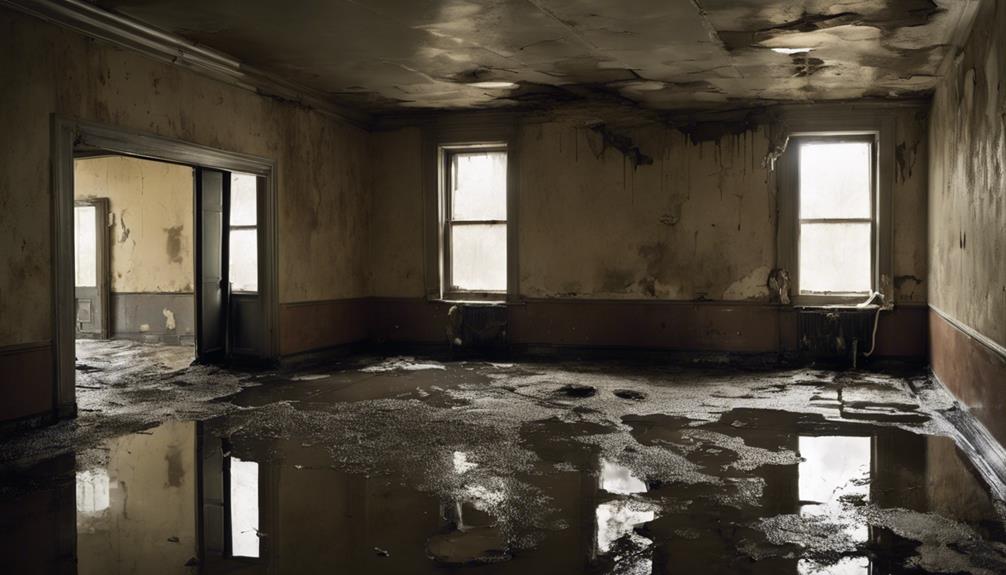
Delayed repairs for water damage can have serious consequences that extend far beyond mere inconvenience. If a landlord doesn't address water damage quickly, you may face significant health risks, such as mold growth, which can develop within just 24 to 48 hours. This can affect your safety and well-being in the property.
Moreover, neglecting urgent repairs can lead to structural issues, which often means higher repair costs down the line—sometimes even thousands of dollars.
As a tenant, you have rights. If your landlord fails to make necessary repairs within a reasonable timeframe, you might've grounds to withhold rent, potentially leading to legal disputes. Landlords who ignore their responsibilities may find themselves facing lawsuits for breach of the warranty of habitability, along with financial penalties.
Persistent water damage not only impacts your living conditions but also compromises the property's integrity. This can lead to long-term depreciation and decreased property value, affecting both you and the landlord.
In short, timely repairs are crucial for maintaining a safe, habitable environment for everyone involved.
Numerous resources are available to help tenants navigate the challenges of water damage repairs. In California, it's crucial to understand your rights regarding urgent repairs. If you report water damage to your landlord in writing, you create a formal record, which is essential for tracking timelines.
Remember, landlords must address urgent issues within 24 to 72 hours, while non-urgent repairs typically take up to 30 days.
To strengthen your position, document the damage with photographs and keep detailed records of all communications regarding repair requests. If your landlord fails to act promptly, you may have legal remedies at your disposal. Options like withholding rent or utilizing the "repair and deduct" method can be effective, but ensure you provide proper notification first.
Additionally, local tenant advocacy groups and the County of Los Angeles Department of Consumer and Business Affairs offer valuable guidance and support for tenants dealing with unresolved water damage issues.
Don't hesitate to reach out to these resources—they can help you navigate the complexities of landlord-tenant laws and ensure your living conditions meet safety standards. Being informed empowers you to take action when needed.
In California, a landlord's timeframe to fix issues depends on the urgency. For emergency repairs, you should expect action within 24 to 72 hours.
For non-urgent repairs, like minor leaks, you might wait up to 30 days after you've submitted written repair requests.
Your lease agreement outlines these obligations, ensuring your rights as a tenant.
If they fail to meet these maintenance obligations, you can explore legal remedies to enforce habitability standards.
In California, landlords must address mold problems promptly, especially if there are health risks involved.
You should notify your landlord in writing to establish your tenant rights and their legal obligations.
Typically, repair timelines for mold remediation are around 30 days for non-urgent cases, but urgent issues need immediate action.
If they fail to act, you have tenant remedies, including withholding rent or pursuing legal action, to ensure compliance with inspection processes and responsibilities.
In California, uninhabitable living situations include serious safety violations like severe water damage, mold growth, or lack of essential services.
As a tenant, you have rights regarding habitability standards and your landlord's legal obligations. If problems arise, you must provide notice and allow reasonable repair timelines.
If your landlord fails to act, you can explore tenant remedies, including withholding rent or initiating eviction processes, depending on your rental agreement's terms.
In California, landlords must restore your water service promptly, typically within a few days if it's completely shut off.
Under water shutoff regulations, you're entitled to a habitable living environment. If your landlord neglects this responsibility, you can invoke tenant rights and pursue legal remedies.
Document your tenant notifications to ensure a clear record of issues. Emergency repairs should be prioritized, and you may also want to consider water damage insurance for added protection.
In summary, it's crucial to know your rights as a tenant when it comes to water damage repairs. Your landlord has a responsibility to address urgent issues promptly, while non-urgent repairs may take longer. Always notify your landlord about any damage and keep records of your communications. If they delay necessary repairs, you have options to seek help. Stay informed and proactive to ensure your home remains safe and comfortable.